‘Heer~Infantry’ mid & late war Uniforms:
Hauptfeldwebel, 6th Infantrie Regiment:
Originally a Reichswehr Infantry Regiment, the 6th was expanded into the 30th Infantry Division. Composed of recruits from Schleswig-Holstein, the division contained 3 Infantry Regiments: the 6th, 26th, and 46th. The division, led by Major General von Briesen, countered one of the most serious Polish counterattacks; leading the last of his reserves, Briesen's had his left arm was shattered and amputated. Shortly, Hitler and Keitel visited the division and awarded the Knight's Cross, the first awarded to a divisional commander.
The division, nicknamed the "Briesen Division," fought in Belgium, fighting on the Russian Front it was encircled at Demjansk, then fought in Leningrad, and finally surrendered in the Courland Pocket. This Hauptfeldwebel wears a uniform practical for the hot, humid weather found around Leningrad during the summer.
A Spiess, he is the company's top kick or I" Sergeant with his authority shown by the "piston rings" on his sleeves and his ever-present "reporting book." A long-serving combat vet, he wears the Ost Front Ribbon as well as the Demjansk Campaign Shield. A Reichswehr veteran, he wears the Army Long Service ribbon with the gold device and several combat awards. His combat leadership is evidenced by his Iron Cross I and 2ndClass; his courage by his Close Combat Clasp in Silver and Wound Badge. When not wearing a helmet, he wears the popular M43 cap, this one custom sewn in like material to the tunic and the trousers.
Note: The last picture is a period, Panzer officer with the DEMJANSK Shield on his sleeve.
Most of the uniforms in the collection, at one time, had pictures, of similar uniforms, for reference, that we used and to share on the site, but that was the original site, it has been through several crashes, moved around platforms, etc, so I use what I what I find on the internet now, If I see something close, but then ya next to never know where there from. So, sorry if the period pictures don’t match exactly my uniforms, I still try to get the picture from the same unit if nothing else.
Unteroffizier Waffenmeister, Waffen-Werkstatt, Infanterie-Regiment 128:
Care of small arms is one of the primary jobs of a soldier. When wear and tear has taken more of a toll than the soldier can remedy, a much higher skill level is required. So talented Soldiers were selected for technical competence and sent to the Heeres Waffenmeister-Schule, such as the one located in Offenburg in Baden, which is part of Wehrkreis V.
At these schools, Soldaten and Unteroffizier were challenged with courses lasting 3 to 5 months in maintaining various weapons systems. Mercedes-Benz L3000 Rapid repair and reissue of weapons was critical. Non-operational weapons were rushed from the Kompanie to the regimental level, where Waffenmeister sorted those that could be repaired at this level and dealt with them at a mobile workshop.
Der Waffen-Werkstatt or repair shop of the regiment in the field is based on one or two trucks such as the Verstärkerkraftwagen (Kfz. 24) u. Mercedes-Benz L3000. These trucks contained the specialized Werkzeugsatz or tool kits for individualized weapons utilized by the regiment. The early war Infanterie Regiment contained 3,250 men.
It issued and maintained 159 Maschinengewehr. The Waffenmeister was responsible for those, as well as over 3,000 K98k rifles, other small arms, anti-tank, mortar, and light artillery. Specialized knowledge, tools, and repair parts were constantly in use. The Unteroffizier wears a custom Dienstauszug u Feldmütz made from captured stocks of Soviet cotton cloth. Prewar Schulterklappen, with machine embroidered regimental number IR 128, have been sewn into the shoulder joint. Silver piping around the Waffenmeister insignia indicates senior technical ability.
Schütze, Grenadier-Regiment. 6, 30. Infantrie-Division:
Grenadier-Regiment 6, renamed in 1943, was one of the three Grenadier Regiments of 30. Infanterie Division. 30. Infanterie-Division was created in October 1936 in Lübeck and mobilized on 26 August 1939 for the invasion of Poland. At that time, it consisted of the usual German infantry division elements: Three infantry regiments of three battalions each, one three-battalion regiment of light artillery, one Heavy Artillery battalion, a Panzerjäger battalion, an Aufklärungs battalion, a signals battalion, a Pioneer battalion, and divisional supply, medical, and administrative units.
During the Battle of Bzura, the division suffered heavy losses, and Major General von Briesen led the division’s last reserve battalion into battle to thwart violent Polish counterattacks. Briesen was seriously wounded in the action, losing his right forearm, and for the rest of the war, the unit was known as the "Briesen Division".
Part of Armee Gruppe Nord during Operation Barbarossa, it was one of the units trapped in the Demjansk Pocket. Remaining in Russian, the division was deployed to defend Staraya Russa, fighting in the Russian winter offensive in January 1944 between Leningrad and the Ilmensee, the division fell back to the east of Ostrow and Opochka, and later south of Pleskau. From July to October 1944, the retreat was followed by the Baltic States.
The division fought in the "Marienburg" position, fought at the Embach, and retreated in October 1944 via Riga to Kurland. Here, the division took part in the various Kurland battles and fought in 1945 at the Barta section west of Skuodas and southeast of Preekuln.
Demjanks Kessel: In January of 1942, 30. Infantrie Division was encircled in the Demjansk Pocket along with the 12., 32., 123., 290. Infanterie Divisions, 4. SS-Division “TK”, as well as RAD, Polizei, and auxiliary units, a total of about 90,000 German troops and around 10,000 auxiliaries. They were commanded by General der Infanterie Walter Graf von Brockdorff-Ahlefeldt. Supplied by a Luftwaffe air bridge, the pocket held out until it conducted a breakout operation in May. Fighting continued in the area until 1943.
Ärmelschild Demjansk was awarded to military personnel who fought in the Demjansk Kessel. Commemorating the successful defense of the city and area while cut off south of Leningrad. Instituted on 25 April 1943, it was not awarded until after 1 July 1944.
Kurland: Hitler's refusal to evacuate the Army Group resulted in the entrenchment of more than 200,000 German troops in what was to become known to the Germans as the "Courland Bridgehead". Thirty-three divisions of the Armee Gruppe Nord, commanded by Field-Marshall Ferdinand Schörner, were cut off from Ost Prussia and spread out along a front reaching from Riga to Liepāja, retreating to the more defensible Kurland position, abandoning Riga.
Soviet forces launched six major offensives against the German and Latvian forces entrenched in the Kurland Pocket between 15 October 1944 and 4 April 1945. German forces were continually withdrawn by sea and air from Kurland to Ost Prussia until the remaining forces surrendered.
Kurland Ärmelstreifen was issued on 12 Marz 1945. The last cuff title was issued to German forces surrounded and under siege by the soviet army in the Kurland region of Latvia.
The Obergefreiter wears the Feldbluse Model 1944, which is the final pattern of uniform used by the German military forces. Style is often credited with the copying of the British Battle Dress, however, the two-pocket short style was a popular ski and outdoor sports design. I.R. 6 ciphers are displayed on slip-on loops of Feldgrau wool, which greatly simplified the issue and allowed for easy removal for security purposes.
Along with the new design of Feldbluse, the M44 uniform also had newly designed trousers with a built-in cloth belt, deleting the need for Hosenträger and for use with what was now the standard-issue lace-up ankle boot with Gamaschen.
Gefrieter, Anwarter Grenadier-Regiment 122, 50. Infanterie Division, Russland 1943:
The 50. Infanterie-Division was formed on 26 August 1939 from the Grenzkommandantur Küstrin. Although initially formed as part of the 2. Welle or Wave was reorganized on 15 November 1939 as a division of the 1. Welle. After seeing combat in the invasions of Poland, France, and Greece, the division took part in the invasion of the Soviet Union in June 1941, fighting on the southern sector as part of the 11th. Armee. Following the Crimean campaign, during which it helped capture Sevastopol in June 1942, the division fought in the Caucasus and the Kuban. After returning to Crimea in late 1943, the division was destroyed in May 1944 at Sevastopol.
Reformed from the remnants that had been evacuated from Crimea, the division fought in East Prussia, where it was largely destroyed in the Heiligenbeil pocket. The remnants went into Russian captivity at Pillau.
The Gefreiter has been selected as an Unteroffizier-Anwarter. The single loop of tress identifies him as a Non-Commissioned Officer Course candidate. At some point in the near future, he will and others from the division will be sent to the nearest Unteroffizierschule in the meantime, he is assigned additional supervision and leadership roles with soldiers of his section.
Prior to attending Unteroffizierschule, he was issued a new Feldbluse Model 43 as well as the new Einheitsfeldmütz.
He wears the Krimschild, its Criteria; The Krim Shield was instituted on July 7th, 1942, and was to commemorate the German Campaign in the Crimea led by General von Manstein. The award took the form of a shield with a rounded bottom.
The specific criterion for the award was: to have served in the region for 3 months, to have taken part in at least one major combat operation, and to have been wounded while serving in the region. These specifications were set up in part to prevent General Staff officers from receiving the award from “official visits” to the area.
An eagle is positioned on the top, with its outstretched wings spreading across, not only the entire width of the shield but also breaking the edges to both sides. This eagle is the standard Wehrmacht Eagle, and as such is holding in its talons a wreath with a centered swastika. On either side of the wreath are the years 1941-1942, during which time the conquest took place. The body of the shield is decorated with a map of Crimea.
The details on the map include the rivers and six main cities in the area (denoted by a circle). The word “KRIM” is also imprinted on the map. Around the whole shield, up to the eagles’ wings, is an edge with a small intrusion, with the left side of the map protruding into this edge. The award was presented to all members of the 11th German Army and the 3rd Romanian Army that participated in the campaign.
Each recipient was entitled to five copies of the award, and more could be purchased if necessary through LDO outlets by producing the award document that was presented with the shield. Posthumous awards were made to the family of the fallen soldier accompanied by a possession certificate.
As with all campaign shields, the award was worn on the upper left sleeve of the uniform and was authorized for wear on virtually every type of uniform, including the brown party uniform. It is estimated that 150,000 to 250,000 were produced and 100,000 presented.
Infantry Hauptmann, 422 Infantry Regiment, Kurland Survivor:
This Infantry Hauptmann fought till the end of the war in the Kurland, Latvia siege. Surrendering in May of 1945, he boarded the Olaf Traber and went into British captivity in Schleswig-Holstein. This officer's uniform is the standard style worn by officers throughout the war in a field environment.
The rank is denoted by the 4 "pips" on the shoulder insignia, which are piped in white for Infantry. Looking at his sleeves shows the Tank Destruction Badge and the Kurland cuff title instituted on 12 March 1945.
This officer has been in the thick of combat and was awarded the Iron Cross II Class, the War Merit Cross II with Swords, and the Russian Campaign Award, all shown on the ribbon bar. He has won the Iron Cross I Class, the Silver Wound badge for 4 or more wounds, the Infantry Assault Badge, and the Close Combat Clasp in Silver. On his right sleeve is the Tank Destruction Badge awarded for the single-handed destruction of an enemy tank without an anti-tank weapon, like a Molotov Cocktail, or Hand-Grenade, (not with an Antitank gun, or Panzerfaust).
Schützen, Landesschützen Batallion 606:
Landesschützen Batallion VI / IX was mobilized as part of the Ersatzheer in support of the Feldheer on August 26, 1939 in Hanau am Main, Wehrkreis IX. Landesschützen members were men who were deemed unfit for frontline service but acceptable for limited support activities.
Like all Landesschützen Battalions, it was made up of three Kompanie commanded by a Stabskompanie. Batallion personnel provided local security for POWs, bridges, installations, and transportation convoys; all of which could involve Schützen with anti-partisan actions in occupied countries. On April 1, 1940, the Batallion was renamed Landesschützen Batallion 606.
From 4 November 1941, the Battalion provided security in Upper Silesia. In October 1942, the Battalion was renamed Transport-Begleit-Batallion 606 and then in March 1943, the Battalion was renamed Transport-Sicherungs-Battalion 606. From September 1944, the Battalion was used in northern Italy, under Heeresgruppe C.
The Schützen wears the Feldbluse u. Feldmütz Model 1942 was both more effective in cost of production and practical application. The Feldbluse has three major areas of change, the most noticeable being the removal of pleats from the pockets and the increase from a five to six-button front closure.
Not as noticeable was the removal of the internal Cartridge Belt Suspender system, replaced by four fixed straps sewn inside the Bluse. The Feldmütz Model 1942 replaced the decorative cap sides of the previous Feldmütz with a fold-down style that could cover the entire side of the face. This modification was passed into the design of the Einheitsfeldmütz or M43 cap. Aufschiebeschlaufen with the Latin ‘L’ and Batallion number are worn on the Schulterklappen.
Officers Greatcoat:
Oberst (Colonel), Heer Wehrmacht Waffenrock, Infantrie Regiment 78:
The 26th Infantry Division was a pre-Second World War German Infantry Division, a part of the 1st mobilization wave (1. Welle). I was mobilized for the War on September 26th, 1939.
The 26th Infantry Division spent the early war years on the Western Front, taking part in the Battle of France in May/June of 1940, first under the command of the Sixteenth Army (16. Armee) and later the Twelfth Army. The Division transferred to the Eastern Front in June 1941 to serve under Army Group Center (Heeresgruppe Mitte). It also participated in the Battle of Kursk in July 1943.
After this action, the 26th Infantry Division absorbed the 174th Reserve Division (174. Reserve-Division). The Division was disbanded after casualties were sustained near Kowel on September 19, 1944; surviving troops were transferred to the 253rd Infantry Division (235. Infanterie Division).
A new 26th Volksgrenadier Division was formed on September 17, 1944, in the Warthegau (now Biedrusko in west-central Poland), near Poznań by absorption of the 582nd Volksgrenadier Division and remnants of the old 26th Infantry Division. This new division spent the rest of the war on the Western Front under Army Group B (Heeresgruppe B) until it entered U.S. captivity in the Harz in 1945.
This Waffenrock is owned by Oberst aka Colonel of the 78th Infantry Regiment and is shown at a period before the Regiment's change from Infantry to Grenadier, The Oberst’s history with the Regiment is not clear but is from sometime after the Flower Wars” that he had participated 2 of them, and time on the static “West Wall”, Battle of France, and he was in the fight during the First winter in Russia, he also had served in Africa, at least for the allotted time to earn the Cuff Title.
He has earned both Iron Cross II and I Classes, as well as the Infantry Assault Badge. He has been wounded severely but then returned to combat. He wears the Waffenrock with piped trousers, brocade belt, black shoes, and dress schirmmutz.
Feldwebel, Infanterie-Radfahr-Zug, Stabskompanie, 61.Volks-Grenadier-Division:
Raised as part of the II. Welle (2nd Wave) of Infanterie Division in Wehrkreis 1, Ostpreußen, headquartered at Insterburg the divisions contained three non-motorized Infanterie Regiments. The division suffered heavy casualties during its first year in Russia.
In the summer of 1942, each regiment had its strength reduced from three to two Bataillon. During the summer of 1943, the Infanterie-Regiment was reclassified as Grenadier-Regiment. The division was reclassified as a Volks-Grenadier-Division in 1944. Starting in 1939, the division was constantly in combat with only slight reprieves. Following taking part in the storming of Warsaw and a brief period as an occupation force in Poland, the 61st moved to the West Wall or Siegfried Line west of Aachen. At the beginning of the western campaign, they marched from the Aachen area in the direction of Maastricht, taking part in the capture of the Eben-Emael fortress.
The division then took part in the pursuit of the Belgian army via Namur to the Ypres Canal. After the Battle of France, it remained on occupation duty until January 1941, when it returned to its garrisons in Ostpreußen. From June 1941, the division was relentlessly engaged in Russia as part of Armee Gruppe-Nord. In September, it took part in Operation Beowulf, the Attack on the Moonsund Ar- Left: The Feldwebel leads the Infanterie-Radfr-Zug as they make use of a special toggle rope to make speed behind a Stabskompanie vehicle.
In the case of enemy contact, the Zug members would drop the handle and head for the roadside to advance dismounted to Chipelago. After the fall of Tallinn, the Germans had to clear the Baltic Islands to get full and unhindered use of the sea lanes. Units of the 61st division were transported by the Kriegsmarine to Saaremaa, the southern Island of the Moonsund Archipelago as part of the operation.
By October, they had claimed the final northern island of Hiiiumaa. They deployed to the Leningrad area, digging in and remaining until the Red Army offensive in 1944 pushed the front relentlessly west. It was one of the only combat-effective divisions in the Battle of Narva. Evacuated to Ostpreußen, it was cut off and destroyed in the Heiligenbeil pocket, only the division staff was saved, being transported to Festung Königsburg.
The Feldwebel’s Heeresdienstanzug Model 1940 displays Custom-Made Divisional Ciphers. These devices normally were worn to identify the wearer’s specific part of a Divisional Level section, such as a Divisions Stabskompanie (HQ). In the front workshop, the original push-pin devices were not sturdy enough to handle front wear and had to be sewn to the Schulterklappen.
The Schulterklappen have long served, as noted by the addition of a new section of the war period, non-metallic trees to the bottom after promotion. Headquarters defense and security is the Radfahr or bicycle platoon. Their rapid movement in a non-motorized division makes them the vanguard when the division leadership is mobile.
Note: This is one of the uniforms, where the Shoulder boards are actual period items, and the uniform was rebuilt around them. Many of the uniforms this is how it started, from an insignia slash medal collection, and now displayed on the uniforms, to show how I figured they looked.
Infantryman, Summer Uniform, with “Stalingrad Cross”:
Note: The period picture shows the cross on the shoulder boards, yet he is a Gibirgsjager.
Leutnant u. Feldwebel Infanterie Regiment 134 Reichsgrenadier-Division ,,Hoch u. Deutschmeister”:
44. Infanterie Division was formed on 1. April 1938 in Vienna, about two weeks after the Anschluss of Austria. It first saw combat at the start of the war in the Invasion of Poland and also took part in the Battle of France in 1940. After 9 months of coastal defense, the division was transferred East. On 22. In June 1941, the division took part in the invasion of the Soviet Union, attached to Heeres Gruppe Süd. It remained in the east after the failure of Operation Barbarossa, taking part in defensive actions for the winter against the Soviet Army's offensives near Izum and Kharkiv. Refurbished, the division participated in the German Summer Offensive and was subsequently destroyed with the 6. Armee at Stalingrad in Januar 1943.
Rebuilt as Reichsgrenadier-Division “Hoch und Deutschmeister”, in Belgium, when Hitler ordered the Stalingrad divisions should be reconstructed. By the summer of 1943, it was back up to strength and sent to fight in Italy, where it was heavily engaged at Monte Cassino. It withdrew from the Italian peninsula in 1944 and briefly clashed with American forces attacking the Gothic Line. Withdrawn to refit, it was instead sent to oppose the Soviet breakthrough in Hungary.
The division joined the efforts to recapture Budapest with the 6. SS-Panzer Armee, and was subsequently nearly destroyed near Lake Balaton. The remnants of the division retreated into Austria and surrendered to the American forces near Linz. Hoch und Deutschmeister Kreuz was worn on the Schulterklappen of soldiers of Infantrie Regiment 134 ‘Hoch und Deutschmeister’ in recognition of the battle of Stalingrad. The Deutschmeister Kreuz was issued on 23. March 1944 to the members of Infanterie Regiment 134, the Ersatz u. Ausbildung Bataillon and Division Stab.
The device was also worn, unofficially, on headgear. The Deutschmeister Kreuz, the official designation, takes its design from the crosses worn by the chevalier monks of the Deutschmeister Orden, a knightly order dating back to the 11th Century. The “Hoch-und Deutschmeister" Ärmelstreifen was produced in three documented variations. All were machine embroidered in the silver-grey thread; one was in Latin script and the others in Fraktur script.
The Fraktur version on the dark green background was designated for the issue to the logistics element of the Division. The Fraktur on black was designated for the “Hoch-und Deutschmeister” Regiment. The Latin version on black was issued to the rest of the division.
There is little photographic evidence of the Stalingrad Cross (I show several variations and there is a little guess and by golly on their appearance in Silver or guilt, and colors or not, and the use on any caps is not confirmed, some individuals though applied items even though not by the book, some got away with good luck chars and the like.
Reich’s-Grenadier-Division’ Hoch und Deutschmeister, 1st Lieutenant, Waffenrock:
The 44. Infanterie-Division was formed on April 1st, 1938, in Wien (Vienna), largely from the 2. Infanterie-Division of the former Austrian Army, which provided Infantry-Regiment 131 & Infanterie-Regiment 4 ‘Hoch und Deutschmeister’ for Infanterie-Regiment 134. Infanterie-Regiment 132, the third regiment of the new 44. Infanterie-Division was formed from Niederösterreichischen Infanterie-Regiment 6 of the 3. Infanterie-Division.
Under the command of Generalleutnant Albrecht Schubert, the division formed part of General Keinitz’s XVII Armeekorps (14. Armee-List), for the invasion of Poland in September 1939, where it took part in the attack on Krakau and the advance across the Vistula River. The division traveled some 540 kilometers in 18 days of marching and fighting - an average daily march of 29 kilometers! The May 1940 attack on France found the 44. Infanterie-Division was initially held in the OKH reserve at Hamein, being assigned to 6. Armee on May 15, 1940, for combat operations. As rear-guard, it was only lightly engaged, and casualties were minimal for the duration of that campaign.
In the June 1941 attack on the Soviet Union, the 44. Infanterie-Division was a component of von Kleist’s 1. Panzergruppe / III. Armeekorps (motorized), along with the 14. Panzer-Division and the 298. Infanterie-Division for the drive south into and across Ukraine.
In the 1942 summer offensive, as part of 1. Panzerarmee / LI. Armeekorps, the 44. ID. fought its way across the Donets and into the Caucasus, being abruptly assigned north to the soon-to-be ill-fated 6. Armee / XI. Armeekorps for the drive on the Volga. It was here in late November of 1942 that the 44. Infanterie-Division found itself cut off and immobilized, and was reduced to a shell of its former strength in the very bitter battles for the Stalingrad salient.
With the exception but a handful of wounded troops flown out of the doomed city and its replacement unit, the 44th. Infanterie-Division had been lost in the pocket at Stalingrad in mid-1943, a 19th-wave division recruited in Austria, including a small cadre of officers and NCOs flown out as wounded, was formed up to replace the original 44. Infanterie-Division. Its main Infanterie-regiments were renamed grenadier-regiments, and by personnel order of Adolf Hitler, the new division was given the Honorary Title’ (Reichs-Grenadier-Division) “Hoch und Deutschmeister’.
After a brief period, the division was sent to Italy as part of the reserve element for Heersgruppe B in August 1943. In December, the division was sent South of Rome to stem the Allied advance. It would remain in Italy throughout the year, fighting in the bitterly contested battles of the Gothic Line, and notably ‘Monte Battaglia in September of 1944. The division was sent to the Hungarian sector of the Eastern Front in February 1945, where its remnants fought until falling back to Austria, where the division surrendered in May 1945. Portions of the Division surrendered to the Soviets while the majority came into American control near Rosenberg.
This new officer has much previous experience as a noncommissioned officer, as shown by the number of awards he has, dating back to before the destruction of the 44th at Stalingrad. With ribbons from both the Occupation of Austria and Czechoslovakia, he was a German citizen living in Germany before the war. He has proven plenty of combat leadership, having earned the Iron Crosses in 1st and 2nd classes. He has the silver Wound Badge, having survived multiple wounds in action, while he earned the Infantry’s Assault Badge as well as the Close Combat Clasp in Silver.
He wears the Waffenrock he was presented some of these awards in, it has the matching trousers and would have had polished shoes along with a fine Schirmmutz during a formal occasion, while the new division was prepared in 1943. On his shoulders, he has applied the newly authorized ‘Stalingrad Cross’ Ciphers. But then the uniform was put away, into across it, and not seen again when he went to fight in the Italian and Eastern Fronts.
Grenadier, Grenadier-Regiment “Feldherrnhalle”:
Hauptmann, 3. Jager Bataillon, Infantry Regiment 92. ‘Feldherrenhalle’:
The Hauptmann began Service with the German 60th Infantry Division after the battle of France in 1940 as a replacement officer during the upgrade to a motorized unit, taking command of a section of the 3rd Battalion of Infantry Regiment 92. The 60th Division had been formed in late 1939 from Gruppe Eberhardt. A collection of SA that had been engaged in the capture of Danzig during the invasion of Poland. This Division was unusual in that its manpower was made up of people from the SA and the Police. This Division participated in the Invasion of France (1940) and was, in July 1940, transferred back to Poland, where it was upgraded to the 60th Infantry Division (motorized). During this upgrade, it was reduced to two Regiments (the Infantry Regiment 92 and Inf. Rgt. 244). In January 1941, the Division was moved to Romania and in April took part in the invasion of Yugoslavia and Greece.
The Division Participated in Operation Barbarossa as well, advancing through Uman and across the Dnieper River as part of 1st Panzergruppe (commanded by General Von Kleist). It took part in the attack and occupation of Rostov until it was pulled back along with other German troops to the Mius River. The third battalion of the Infantry Regiment 92 was renamed 3. (Jager) Battalion on 17 November 1941 and took on the traditions of the Königlich Preußischen Reserve Jäger Battalion Nr. 27 (Finnishe Jäger) from the First World War.
In a series of defensive battles during the winter of 1941~42, it managed to hold its position, and then in March 1942, took part in the battles of Kharkov. Later in 1942, this division took part in the drive on Stalingrad. During the latter part of 1942, it was involved in bitter battles for the city, then in early 1943, they were encircled at Stalingrad, and the division was destroyed. Evacuated for wounds at Stalingrad, the Leutnant rejoined his unit when it was reforming in mid-1943. The division was ordered to be reformed as a Panzergrenadier formation (60th Panzergrenadier Division Feldherrnhalle) and as part of the Feldherrnhalle organization. The new division spent the rest of the year forming up and training in Southern France.
In November, all the divisional units had their numbers removed and were granted the title Feldherrnhalle. The 271. Grenadier-Regiment Feldherrnhalle formed the Grenadier Regiment Feldherrnhalle and reformed 120. Grenadier-Regiment Feldherrnhalle became Fusilier-Regiment Feldherrnhalle. In December, the division was ordered back to the Eastern front to join the Third Panzer Army, which was involved in the heavy fighting near Vitebsk in Belarus. Arriving in early January 1944, the division fought exceptionally during the fierce battles around the city.
After executing a fighting withdrawal through Belarus, the division was air-lifted via Tartu airport to the Narva Front, where the III. SS Panzerkorps was involved in heavy fighting for the bridgehead over the Narva River. The division remained in combat on the Narva Front, distinguishing itself in what would be known as the Battle of Narva (1944). The division was pushed back towards Minsk, where it was then encircled. In late July, after heavy resistance and several failed breakout attempts, the division was annihilated near the city.
Recovered and promoted, the Hauptmann rejoins the Panzer-Grenadier Division Feldherrnhalle, which is only partially formed by September 1944, when it was ordered to the front in Hungary to strengthen Armeegruppe Fretter-Pico, which was threatening to collapse in the face of a major Soviet offensive near Oradea and Debrecen. The division, in truth only the size of a brigade, was committed to battle in Mid-October and ordered to hold a major crossing point on the Tisza River. When the Soviet spearhead threatened to encircle several panzer divisions near Debrecen, the division was thrown into the battle in an ultimately successful attempt to cut off and annihilate the Soviet units. During the following battle, the division fought alongside both the 13. Panzer-Division Feldherrnhalle and schwere-Panzer-Abteilung 503 for the first time.
After enjoying the major success of the Battle of Debrecen, the division fought in cooperation with sPz.Abt 503 and was soon involved in the withdrawal towards Budapest. The Panzergrenadier Division, sPzAbt 503 and the 13. Panzer-Division Feldherrnhalle, by now completely existed and dangerously understrength, was pushed back into the city. On December 21, 1944, sPzAbt 503 was renamed schwere-Panzer-Panzer-Abteilung Feldherrnhalle. On December 31st, the three formations were encircled along with IX. SS-Gebirgskorps. For the next month, the Feldherrnhalle desperately held out for rescue. After the failure of Operation Konrad, Armeegruppe Balck’s rescue attempts, the pocket collapsed, and the divisions were destroyed on February 12, 1945. One of the few officers left, the Hauptmann leads several hundred Feldherrnhalle men to escape from the pocket.
Hauptmann’s uniform is the standard of the German Army Officer. The Feldherrnhalle cuff title and shoulder board ciphers indicate his service with the unit. His combat leadership is displayed by the Iron Cross 1st and 2nd class. He has been awarded it Infantry Assault Badge as well as the Black Wound Badge. He wears the Ost Front Ribbon, Long Service, and West Wall Ribbons as well.
Note the uniform is part of a set of 2 I have, and the is a panzer crewman’s uniform, but we’ll show that here too.
Feldwebel “Spieß”, Panzer-Regiment 1 “Feldherrenhalle”:
The “Feldherrenhalle” units were combat formations that drew manpower from the “SA”, tracing their history back to the 1923 Beer Hall Pusch. The Feldherrenhalle (Hall of Generals) is the monument in Munich where the coup was crushed, and the units that wore the title were considered the elite of the SA. The original “Feldherrenhalle was not a combat unit, but rather provided guards for the upper echelon of the “SA”. The “Feldherrenhalle” units fought with distinction from 1940 to 1945, and they were considered elite organizations, yet today are all but forgotten.
In March of 1938, the men from the regiment were among the first units to march into Austria during the Anschluss. In September 1938, the “Feldherrenhalle” regiment was placed under the control of the Wehrmacht (the only option, and they were bumping heads with the “SS” in a sort of power struggle, that the SA lost. and part of the was used to form the 271. Infantry-Regiment of the 93. Infantry Division. The 271st fought well in France in 1940 and went on to participate in Operation Barbarossa, where they fought again with distinction on the Leningrad Front.
In the Summer of 1943, the regiment was sent from France, where it was rejoined by its sister regiment (120. IR) after being apart for some 5 years. They were amalgamated into the new 60. Panzergrenadier-Division “Feldherrenhalle”, and then they returned to the Eastern Front in December 1943, where it was quickly involved in the fighting withdrawal in Byelorussia. It was transferred to the Narva Bridgehead, where they were involved in heavy fighting and beaten up, and then they were sent to prop up Army Group Center. The division was annihilated outside of Minsk in late July during Operation Bagration. Members of the division, who had been absent for one reason or another, were ordered to reform the unit back in Germany during the Fall of 1944, forming the Panzergrenadier-Division “Feldherrenhalle”. It was promptly sent to Hungary to help shore up that front, as the German-controlled areas were slowly crumbling. Feldherrenhalle did contribute to (temporarily at least) halting the Soviet drive on Budapest. In February 1945, “Feldherrenhalle” was destroyed a second time, together with other German Units, when Budapest fell. Amongst a small group to escape the pocket was a group from the “Feldherrenhalle” troops.
The surviving veterans were the cadre that formed up the Panzer-Division “Feldherrenhalle-1,” fresh SA recruits filling the ranks. The “New” division became part of the “Panzerkorps-Feldherrenhalle”. The corps was activated at the end of February, with most of the combat units being sent into action at the end of March 1945.
The Panzerkorps immediately executed a fighting withdrawal, towards Vienna and then to Southern Austria. Over the last months of the war, the corps saw heavy fighting and acquitted itself well. By the beginning of May 1945, they were shattered, just remnants left, the corps broke up into small groups in an attempt to reach the American Lines, the troops last finally surrendered on May 9, 1945, most had fallen into the hands of the Soviet Forces and ended up in PoW Camps, few ever saw their homeland again.
As a Senior NCO, “a servicing NCO”, this Feldwebel has been placed in charge of a Panzer-Kompanie acting as the “First Sergeant” or “Spieß”. Standard NCO tress has been applied to his sleeves by order at the unit level, perhaps by a unit member acting as the tailor. The Feldwebel’s proven combat leadership has been recognized by the award of the Eisernes Kreuz II and I Klasse. His time as a veteran Panzer gunner and commander wearing the Panzerkampfabzeichen 50. He also wears his Marksmanship Lanyard, another rarely seen item in the field. He wears a heavily crushed Schirmmutz Cap with the divisional cipher added to it in the Wind-Hound Division style. I added the Black M43, an issue item by this time, and very well may have had as well. He had standard panzer trousers, with short black boots, under the wrap, he wore the standard gray shirt, with black tie, and he had a holstered side-arm on his black leather belt, that had an Enlisted buckle on it, completing the uniform.
The Feldherrnhalle in period photographs:
A few of the existing photographs, top L to R, and top to bottom, 1., Feldherrnhalle propaganda poster, 2, The ‘Feldherrnhalle’ Monument, proceedings going on, 3., Early SA troop, guard with ‘Gorget’, 4., another early troop (Note-collar tab), 5., Late war EM, with hand / sewed in insignia on shoulder boards, and the 6th picture shows a ‘Feldherrnhalle’ officer assigned to a Luftwaffe unit it looks like and very decorated!


















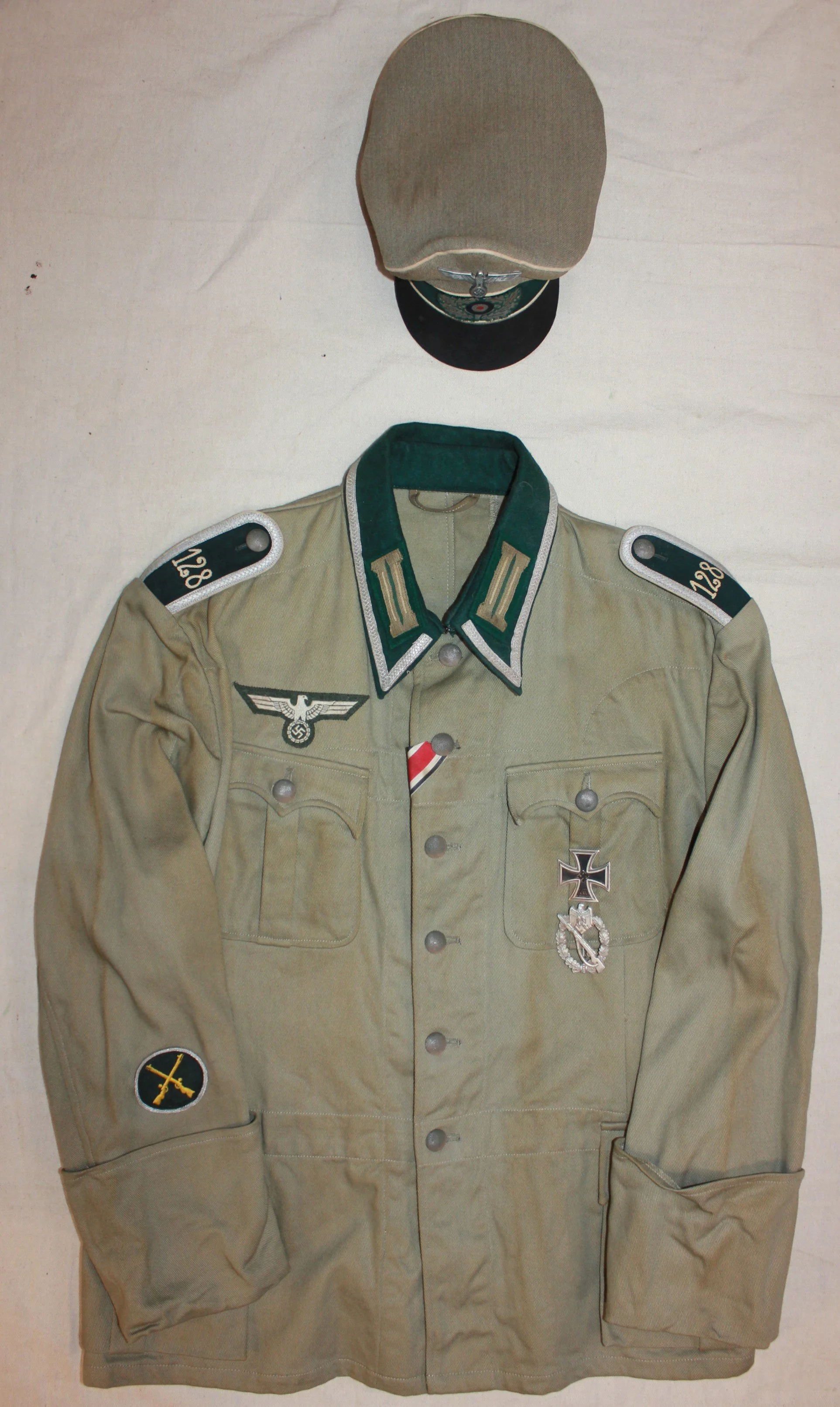
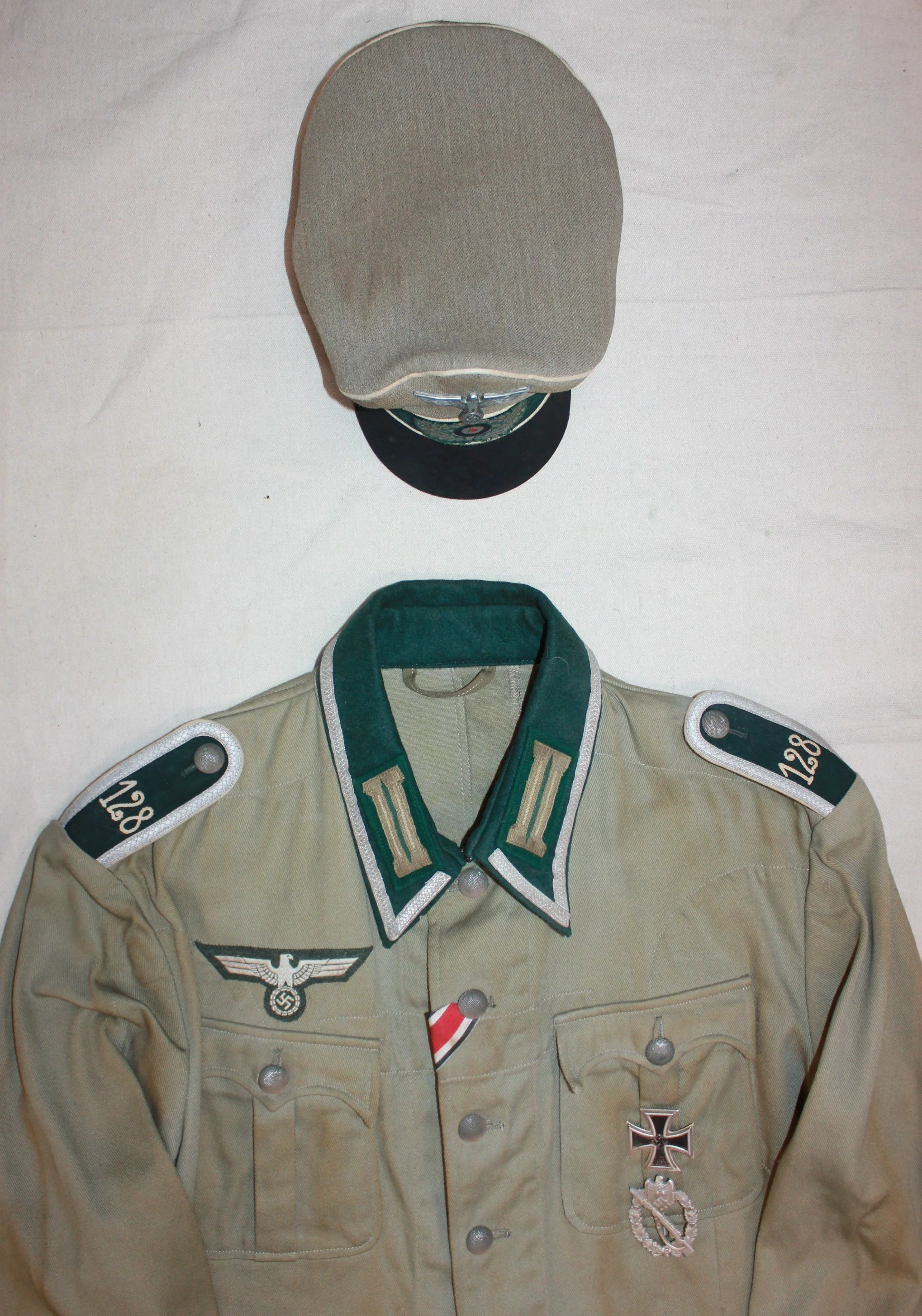


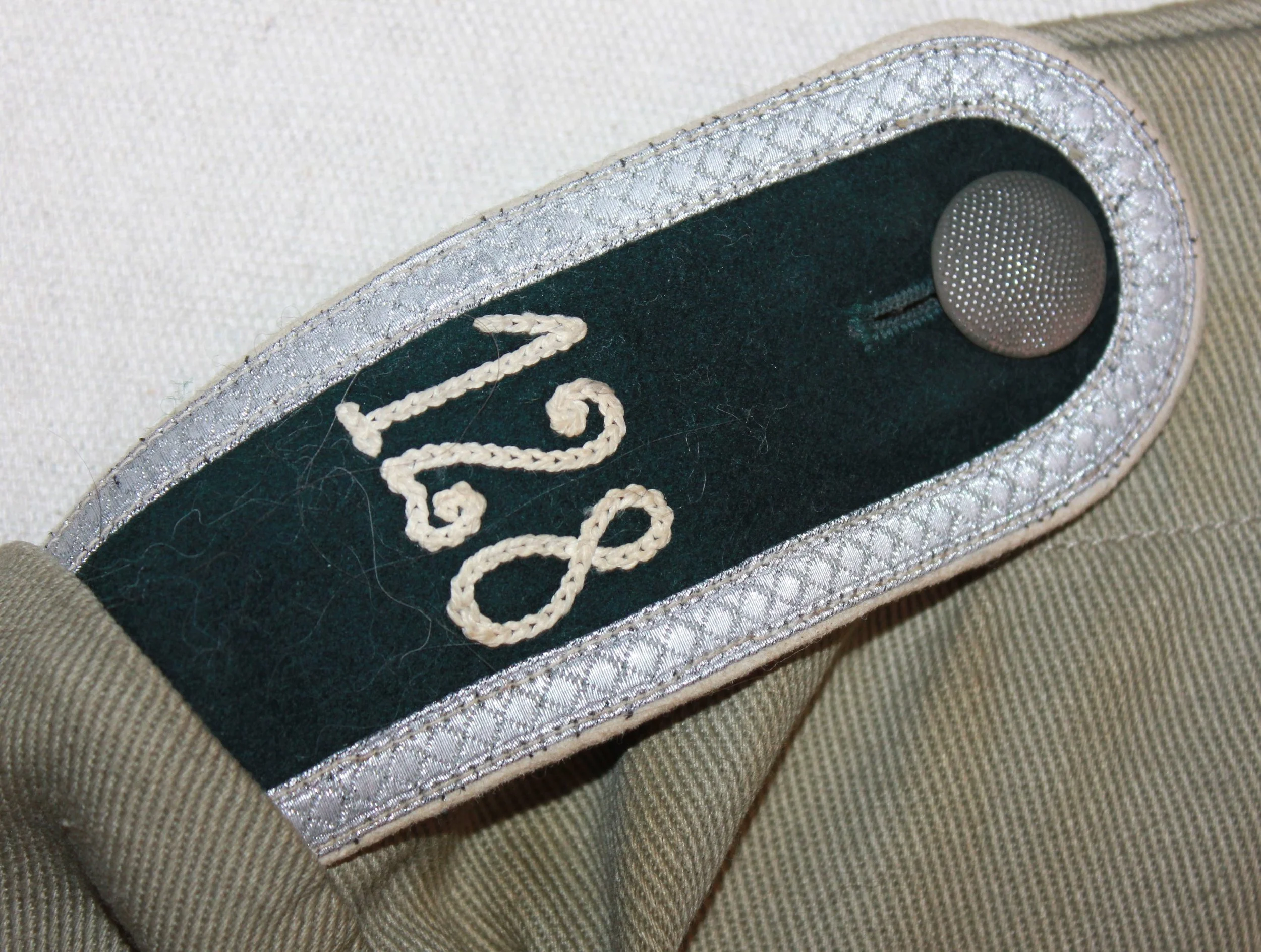
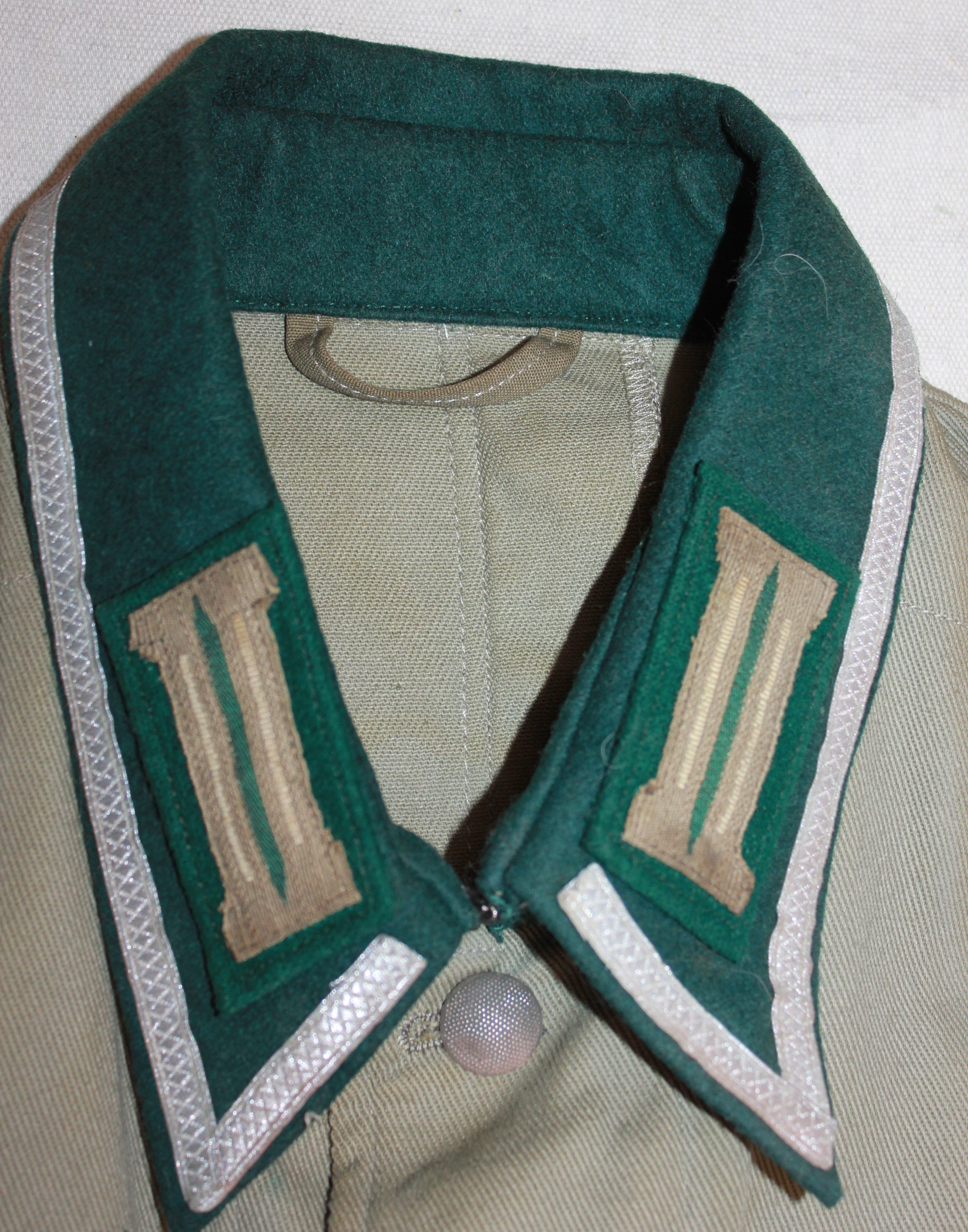
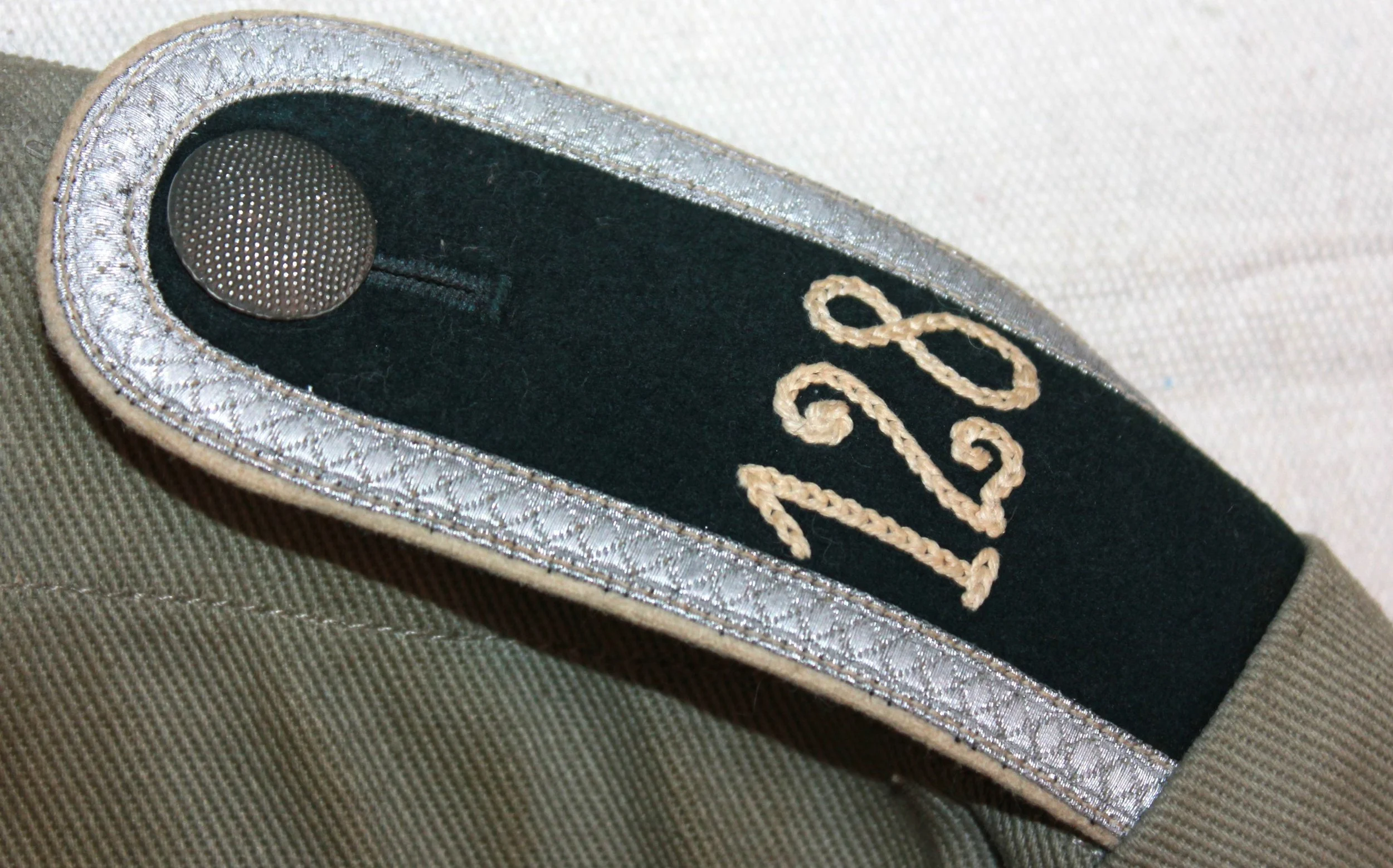

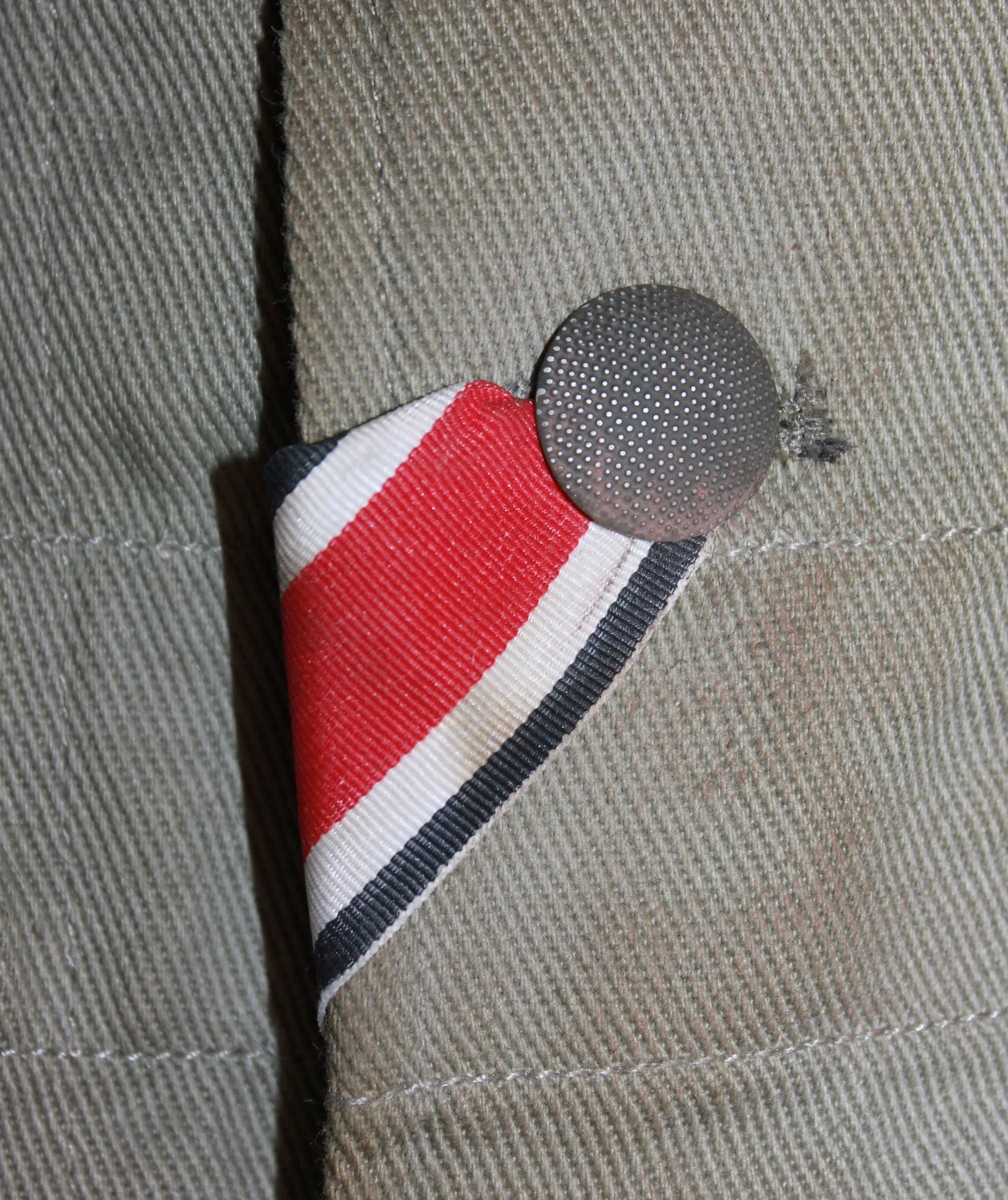

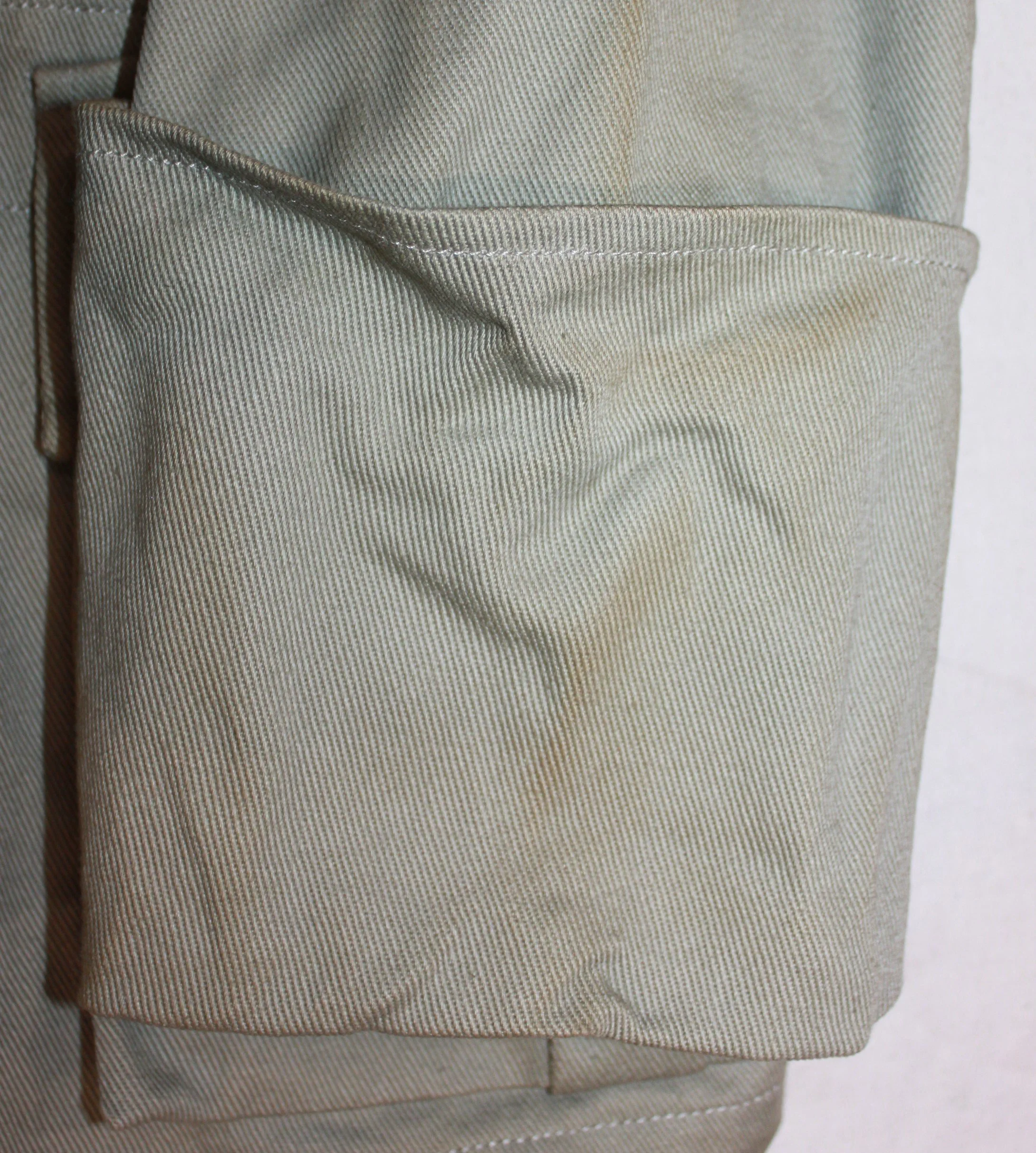


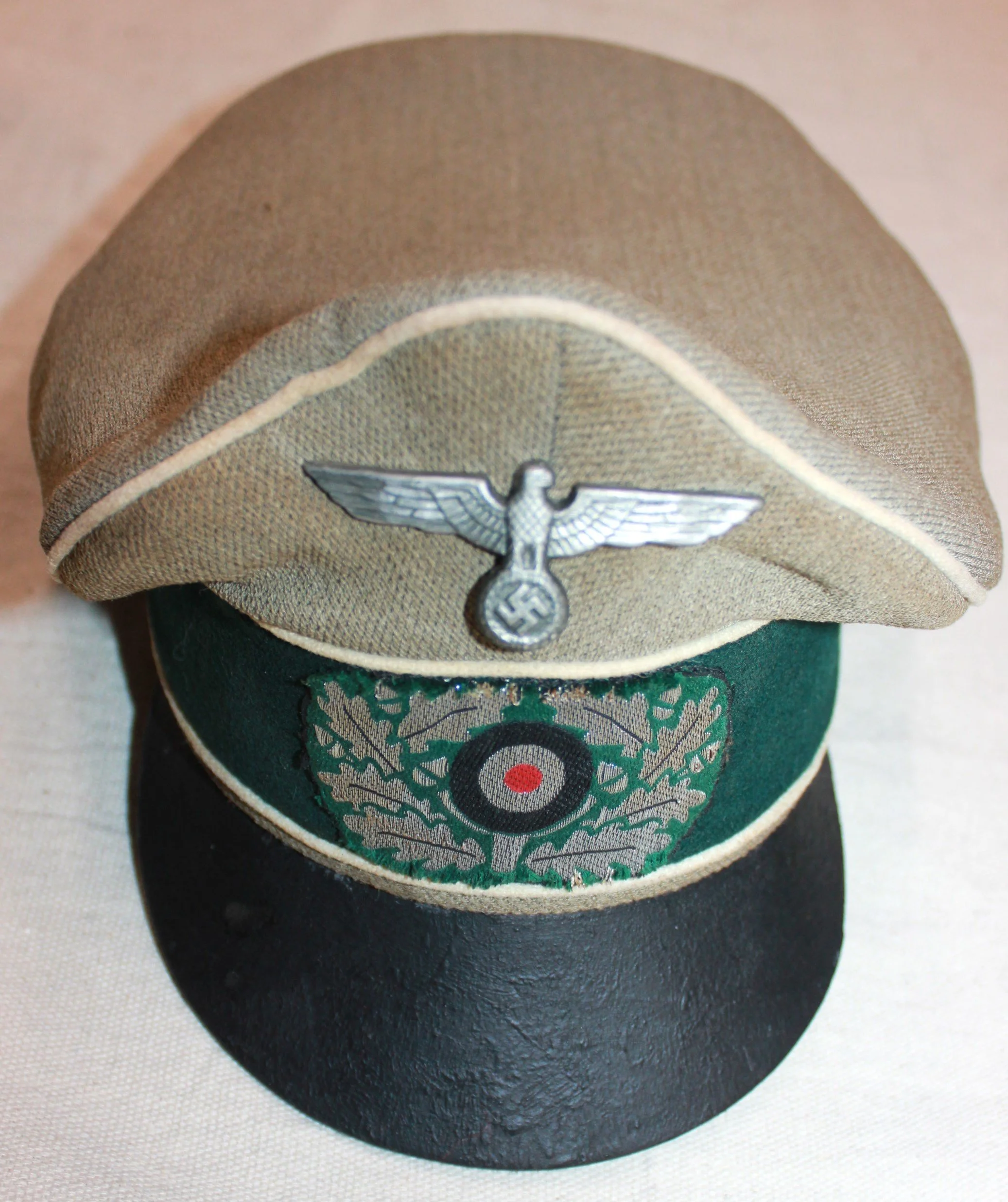

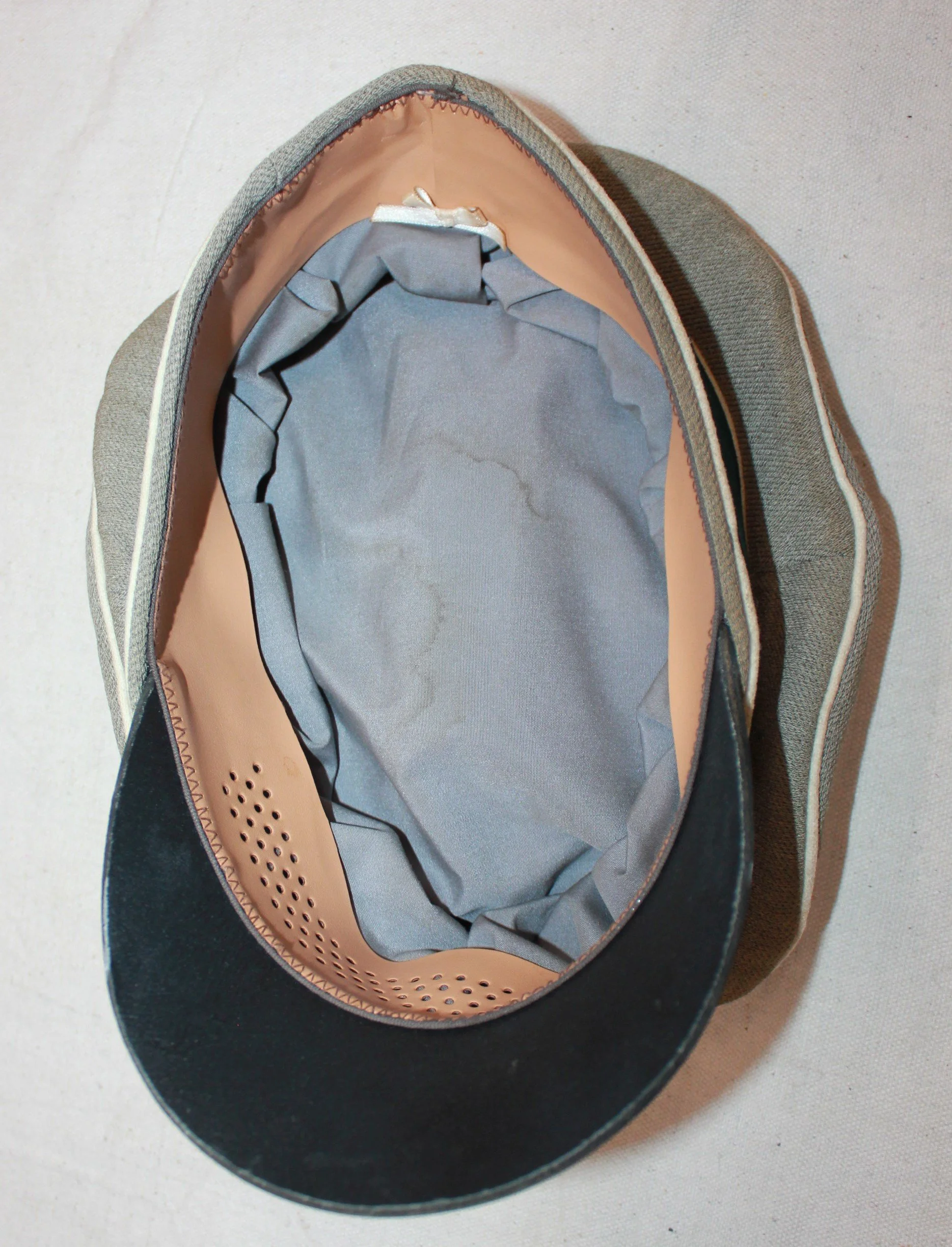








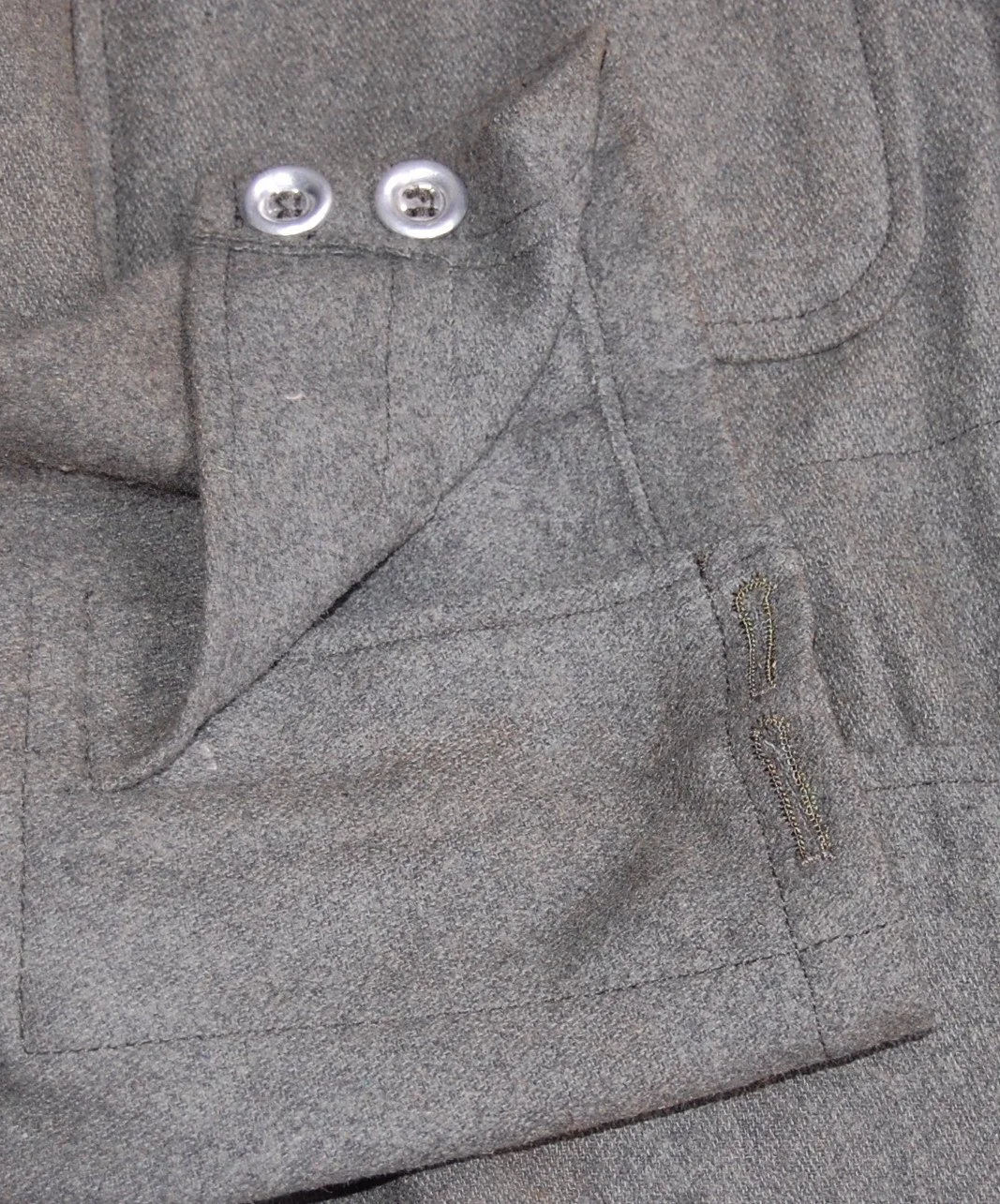

















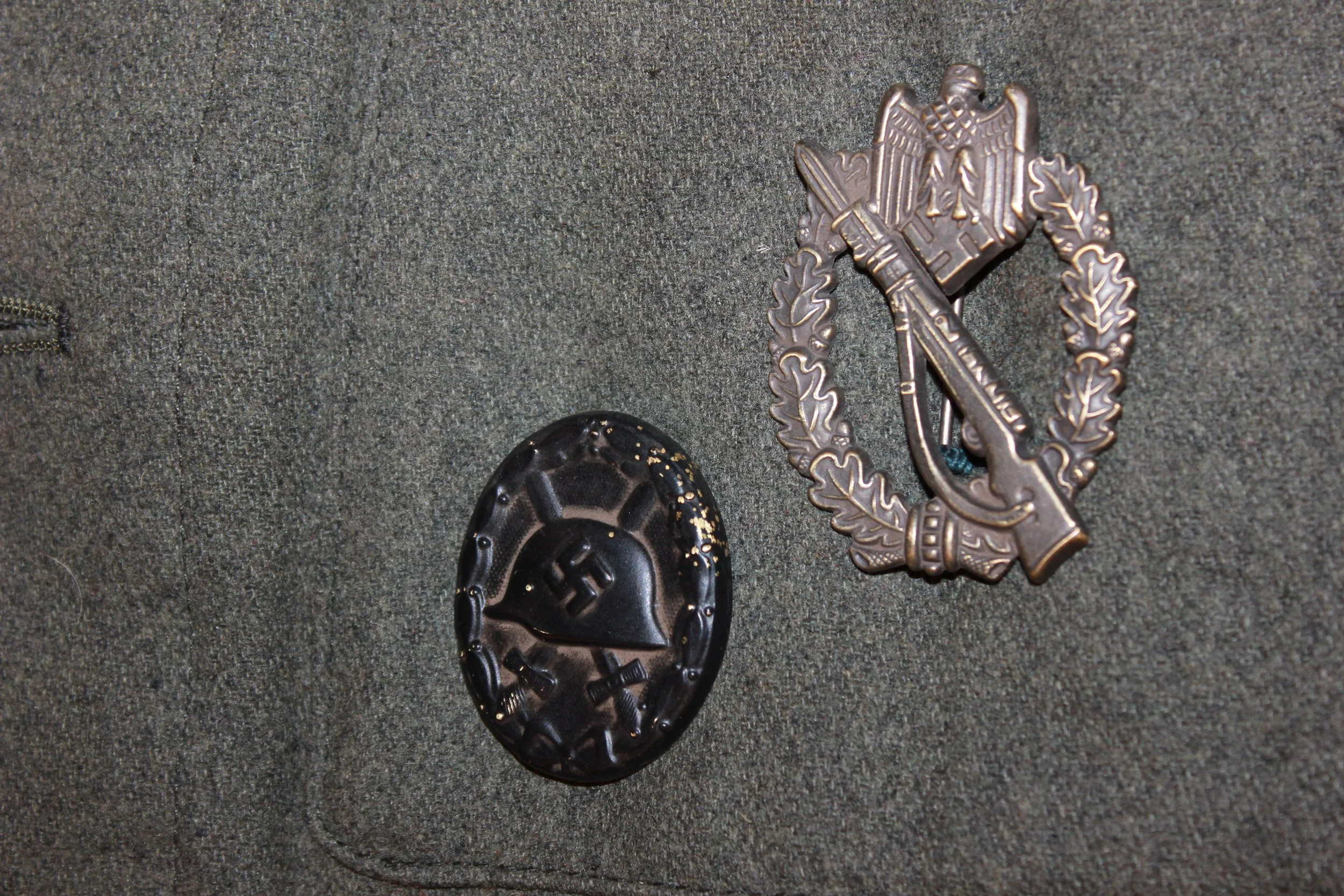



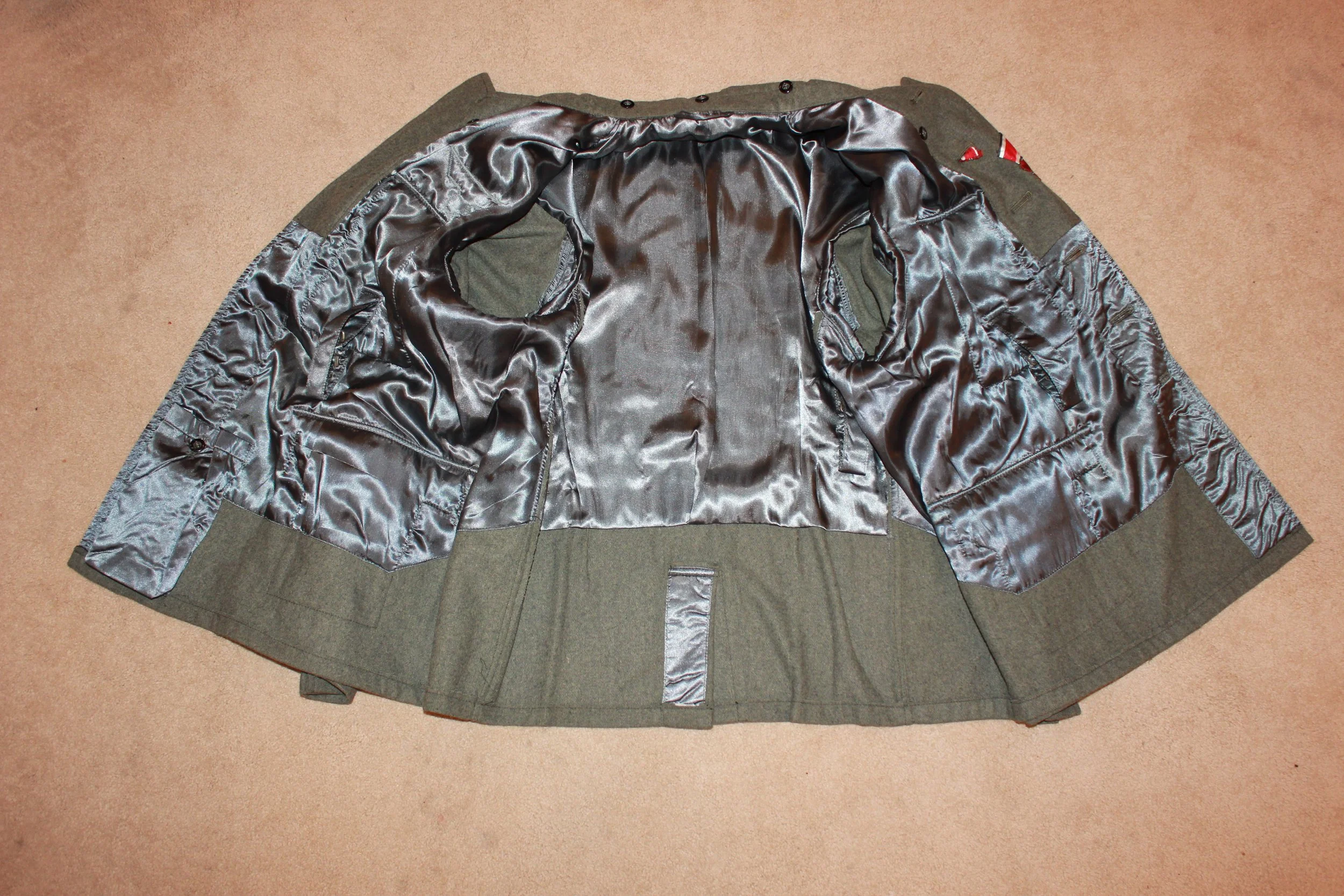


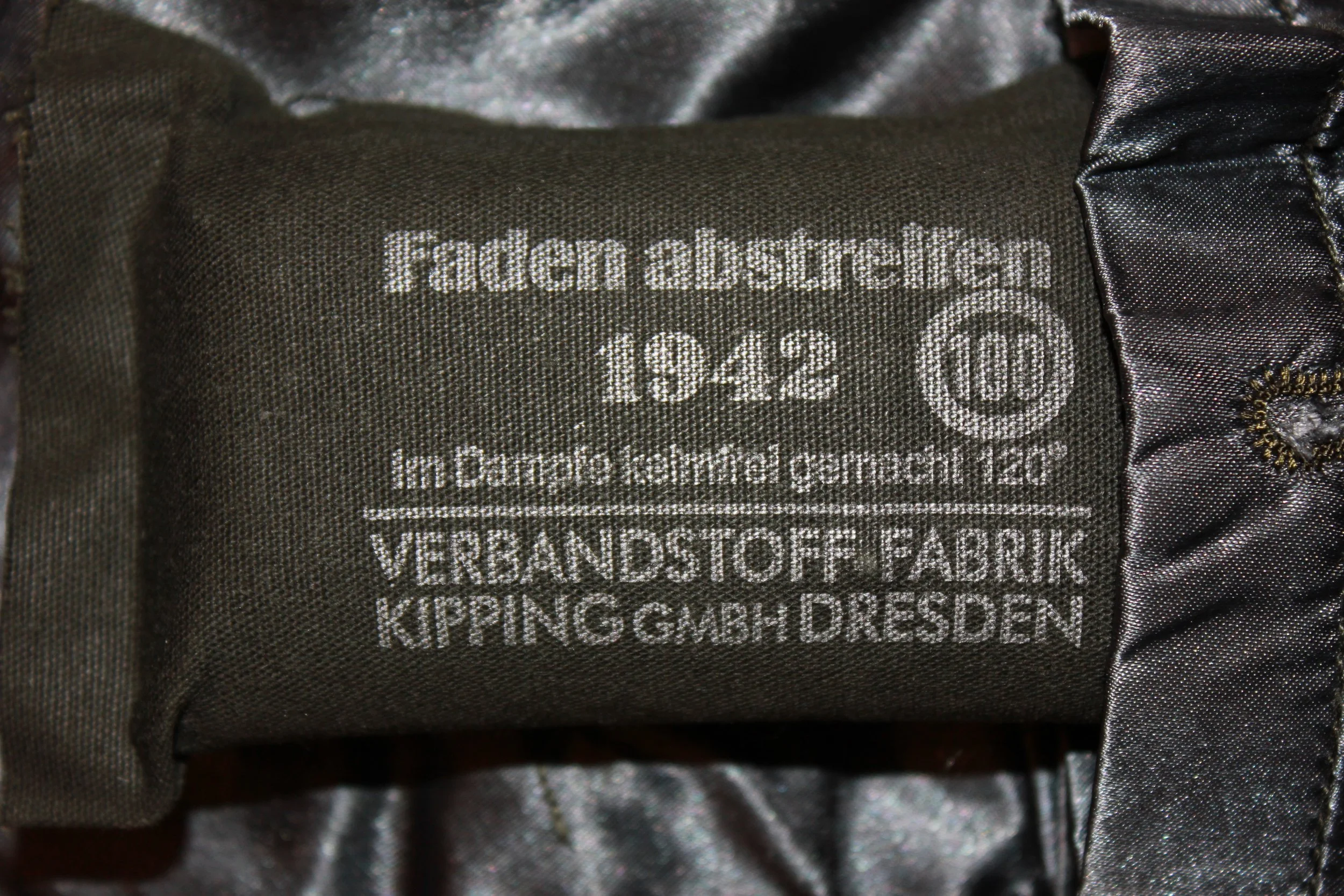























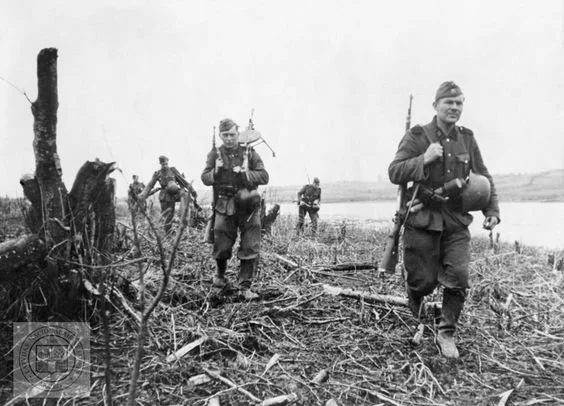

















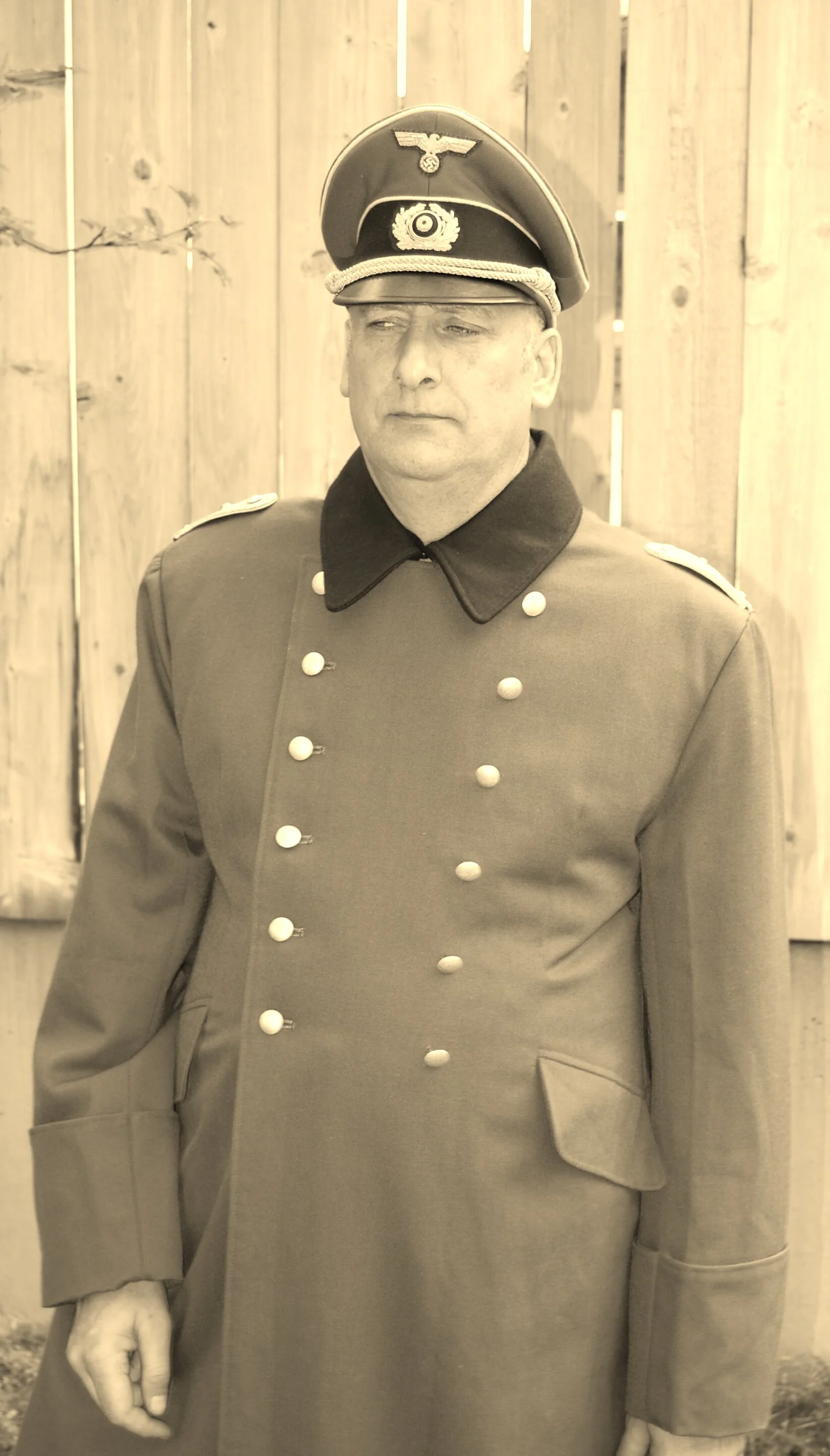














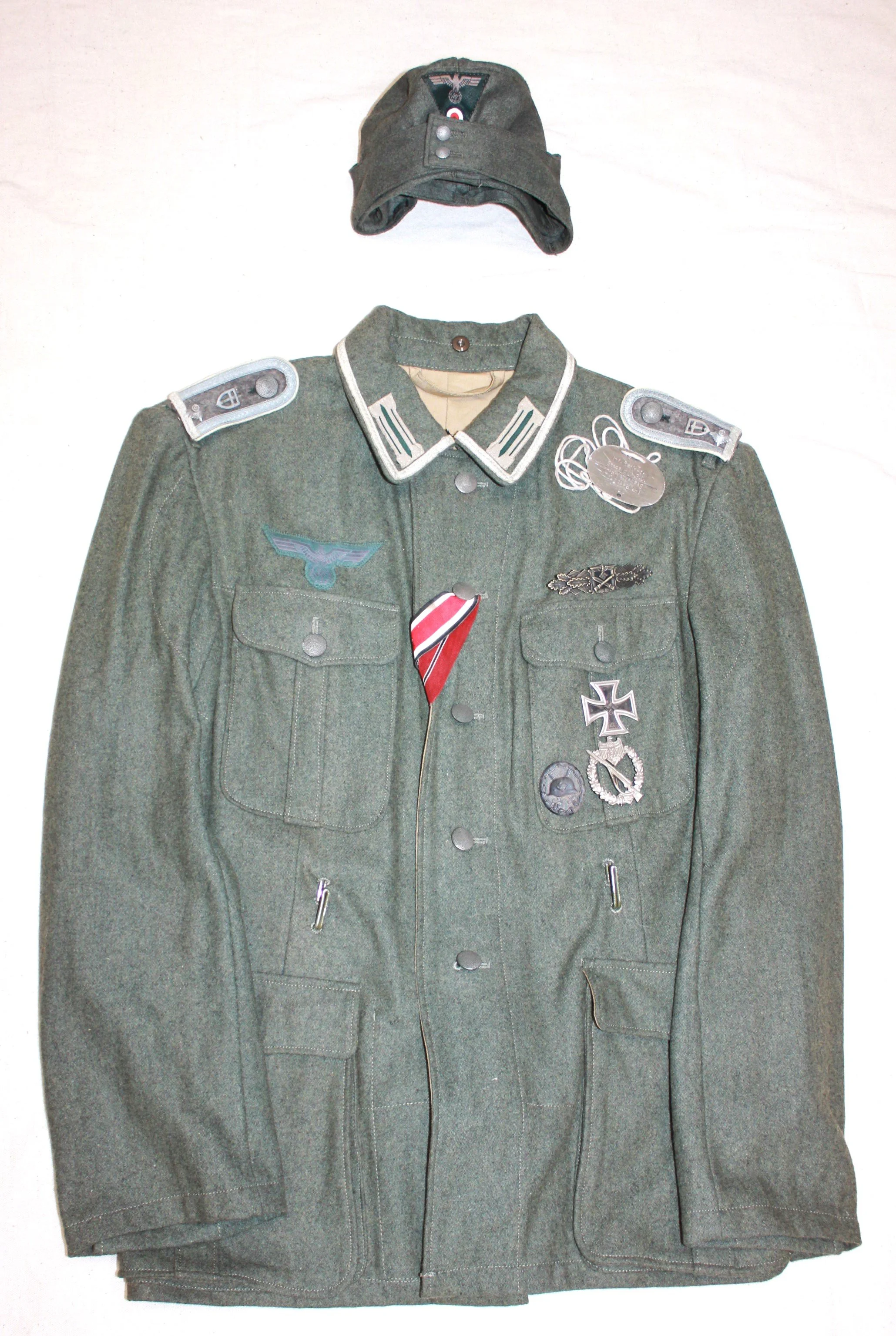

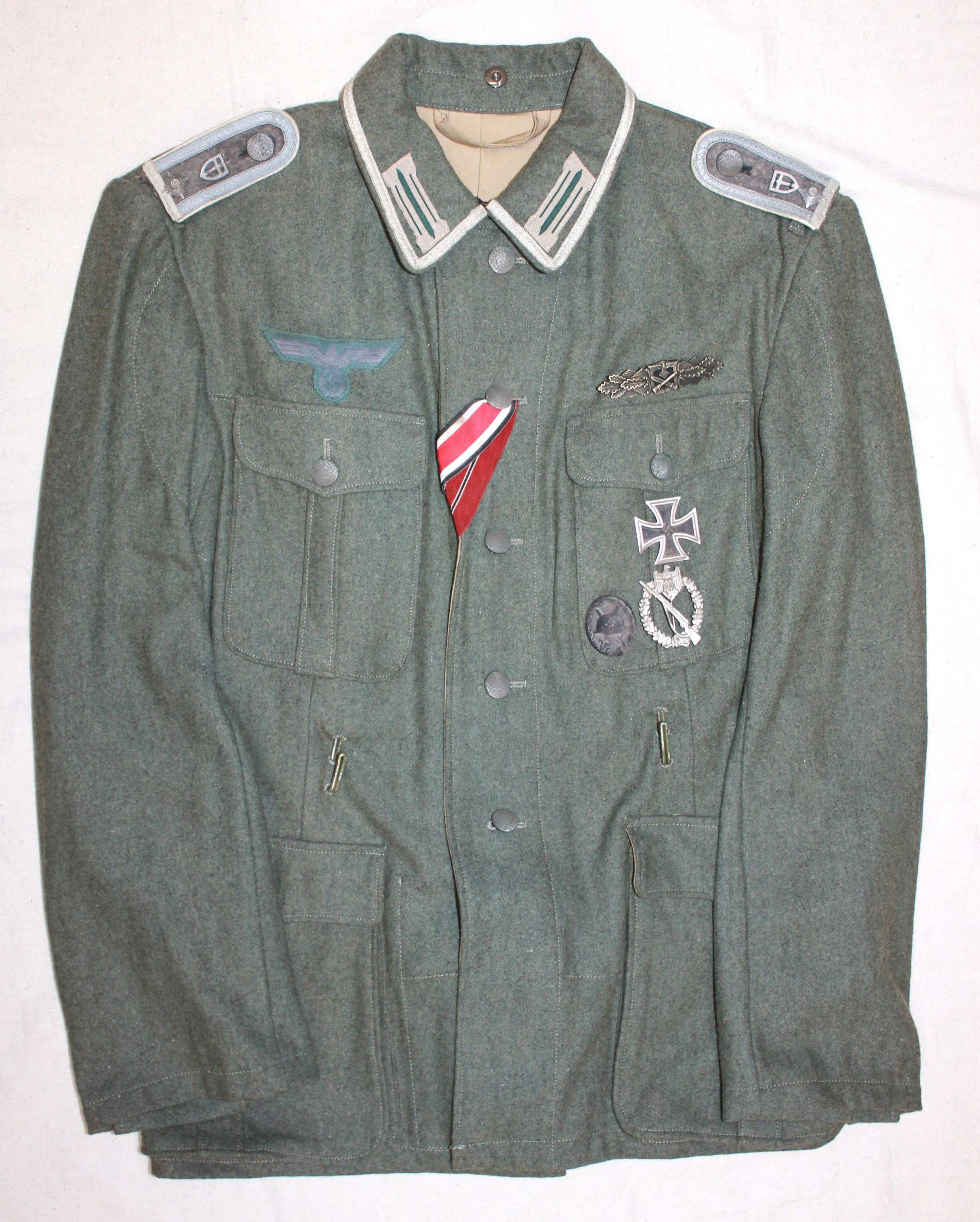

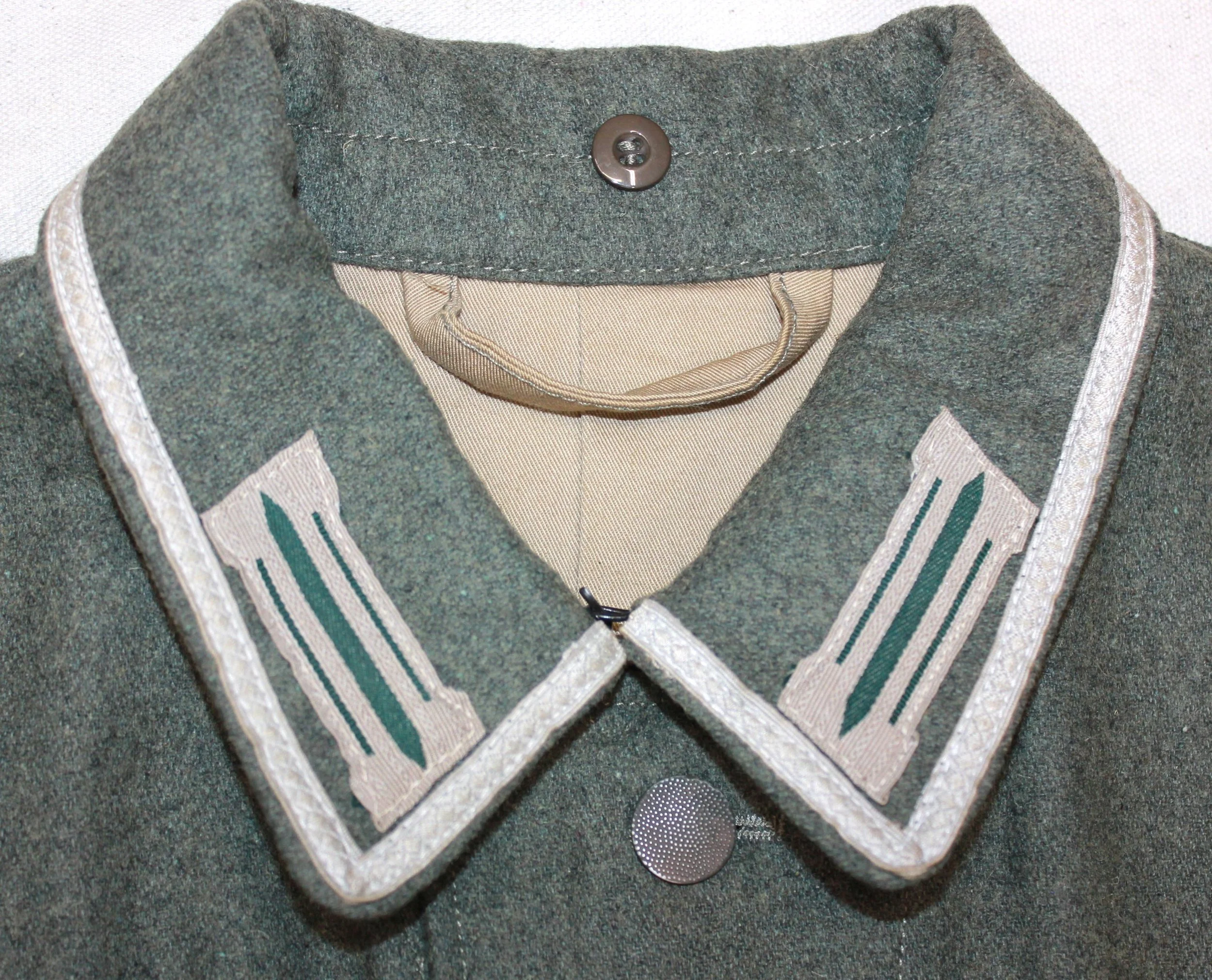

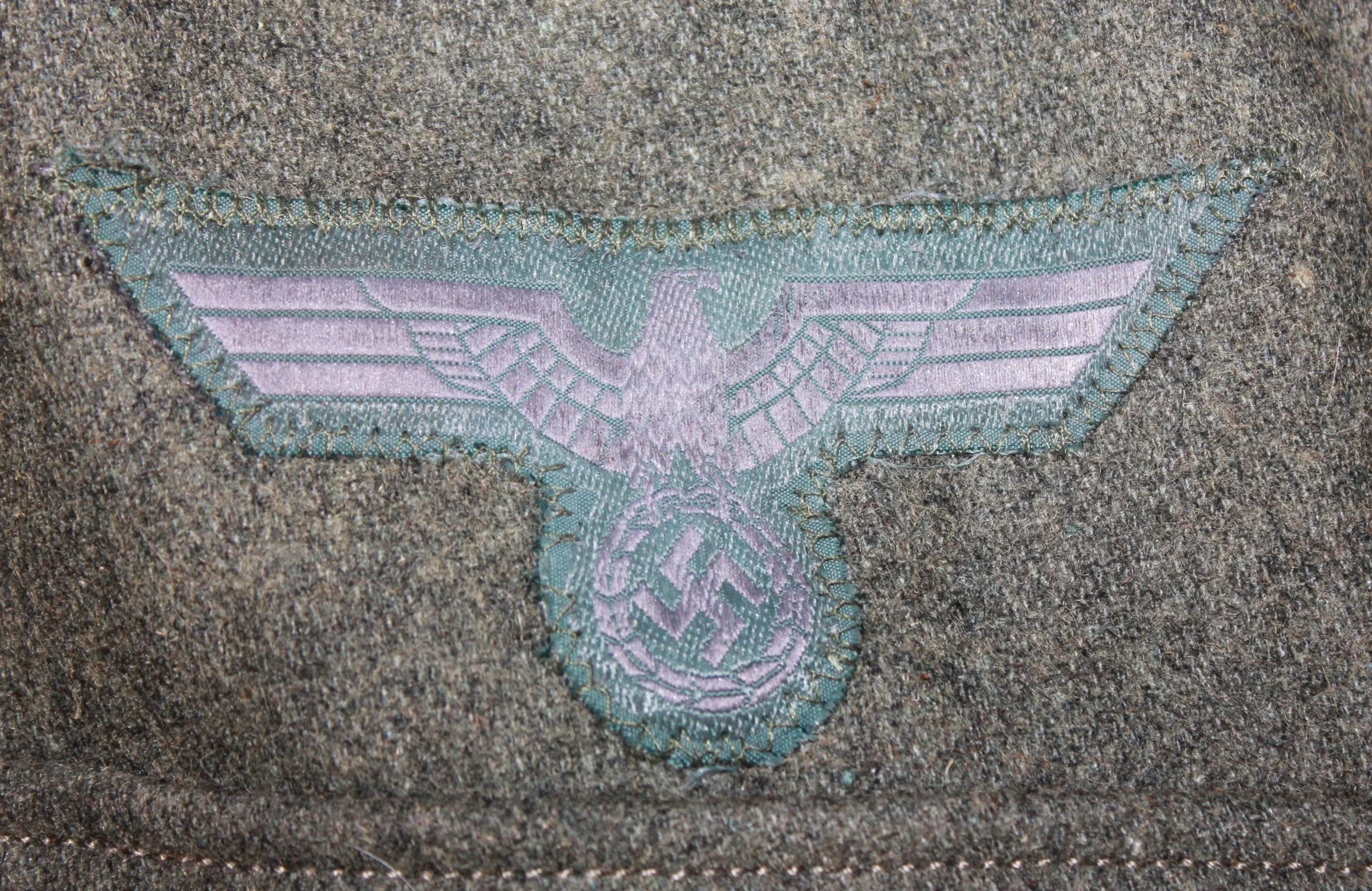
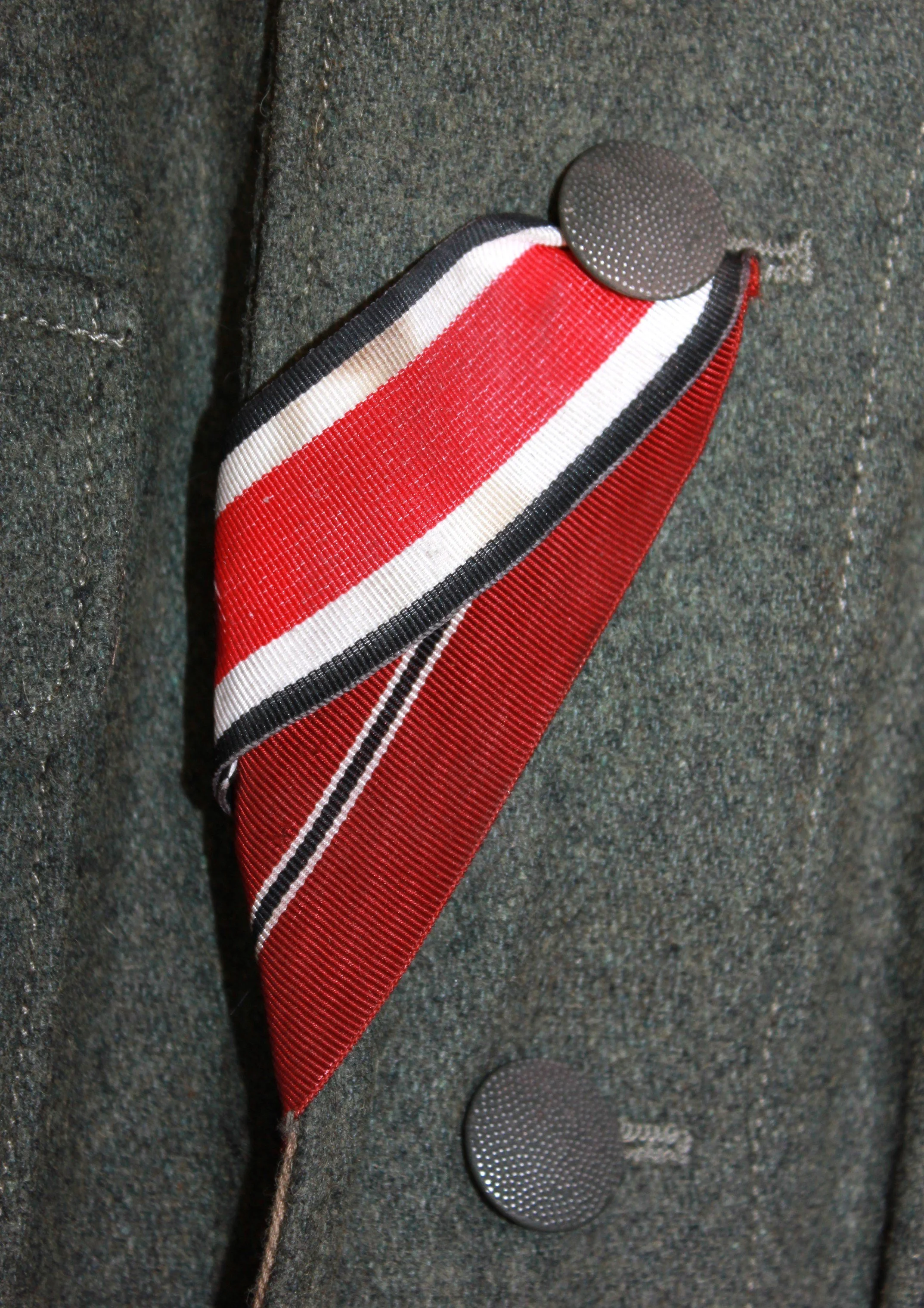


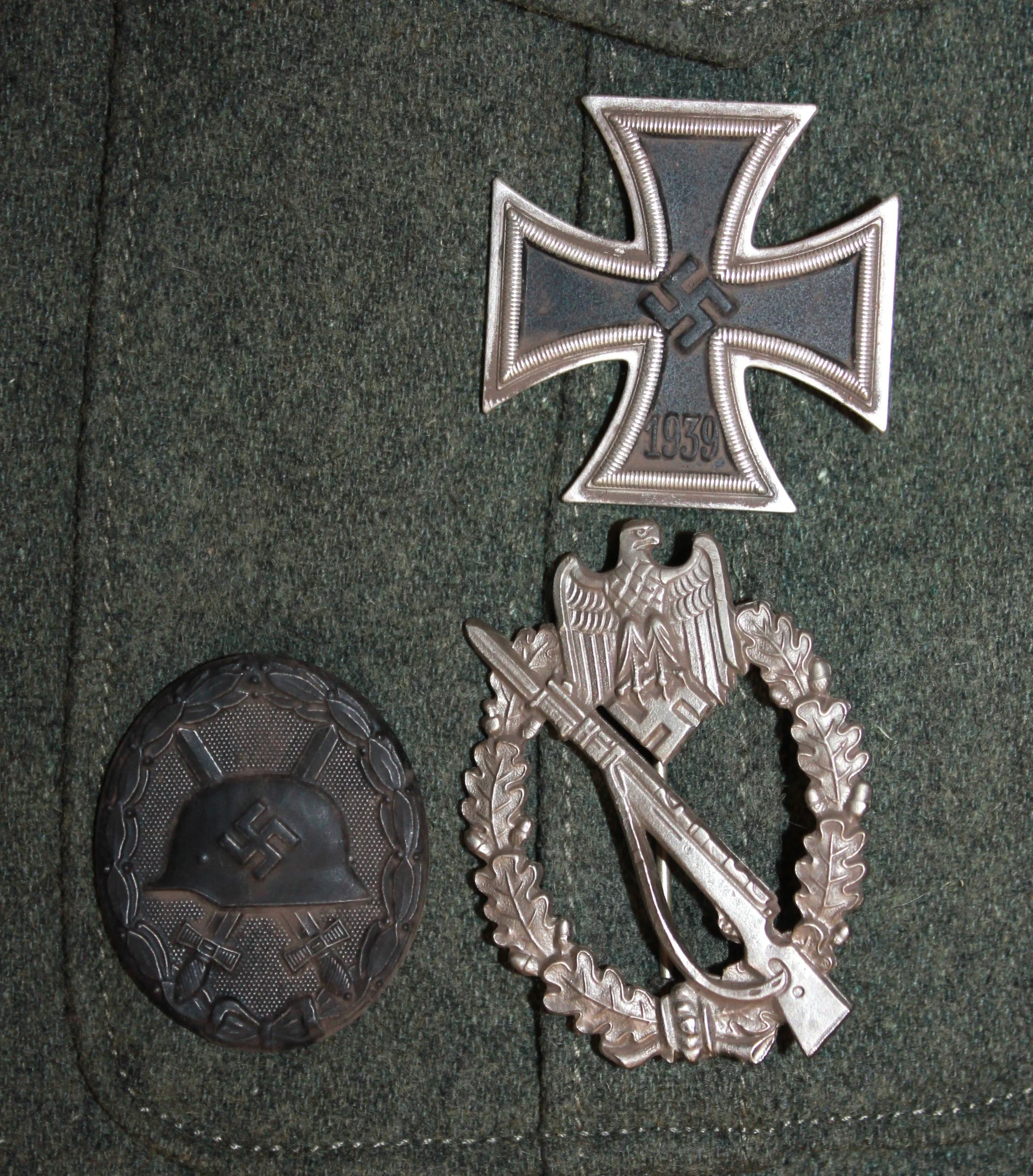
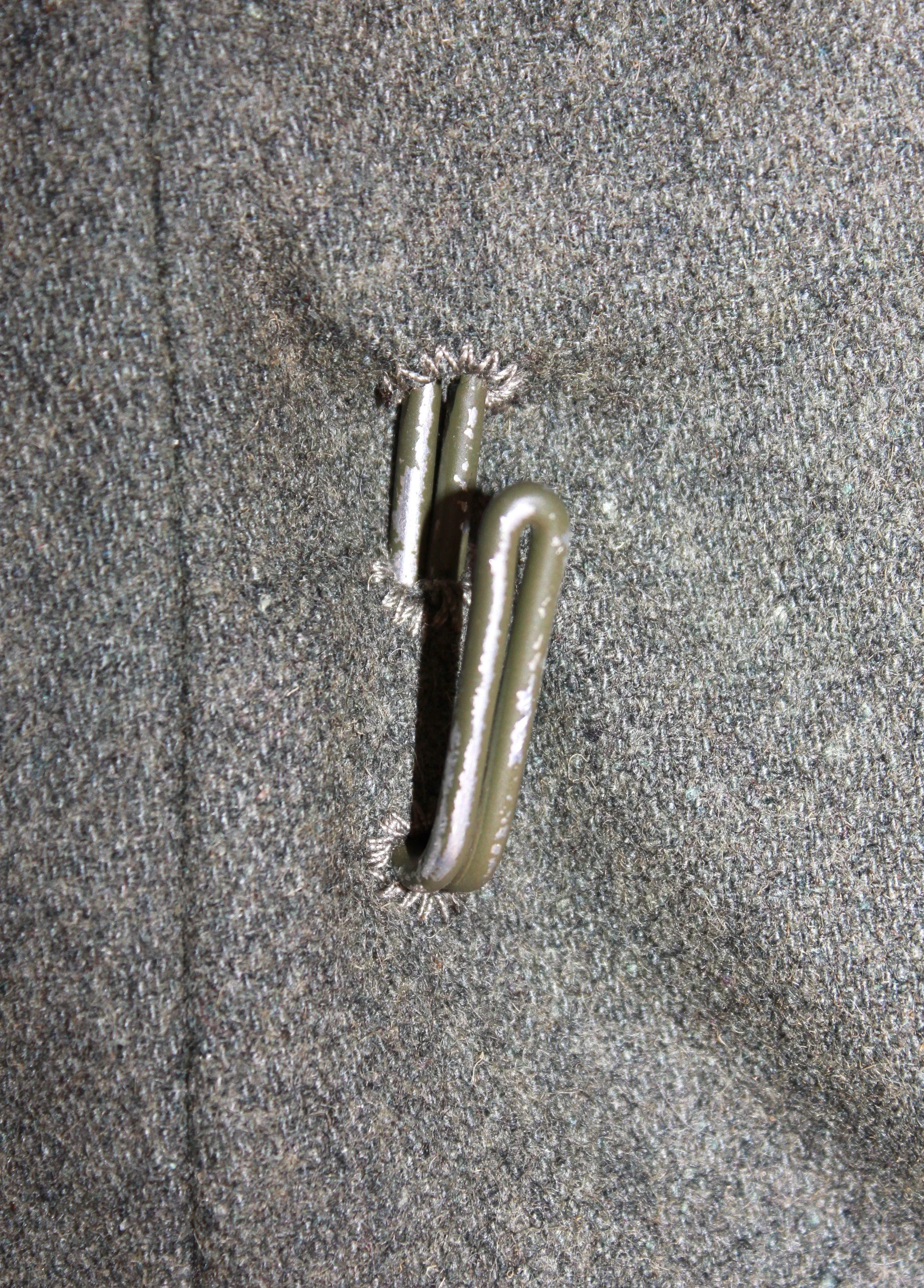




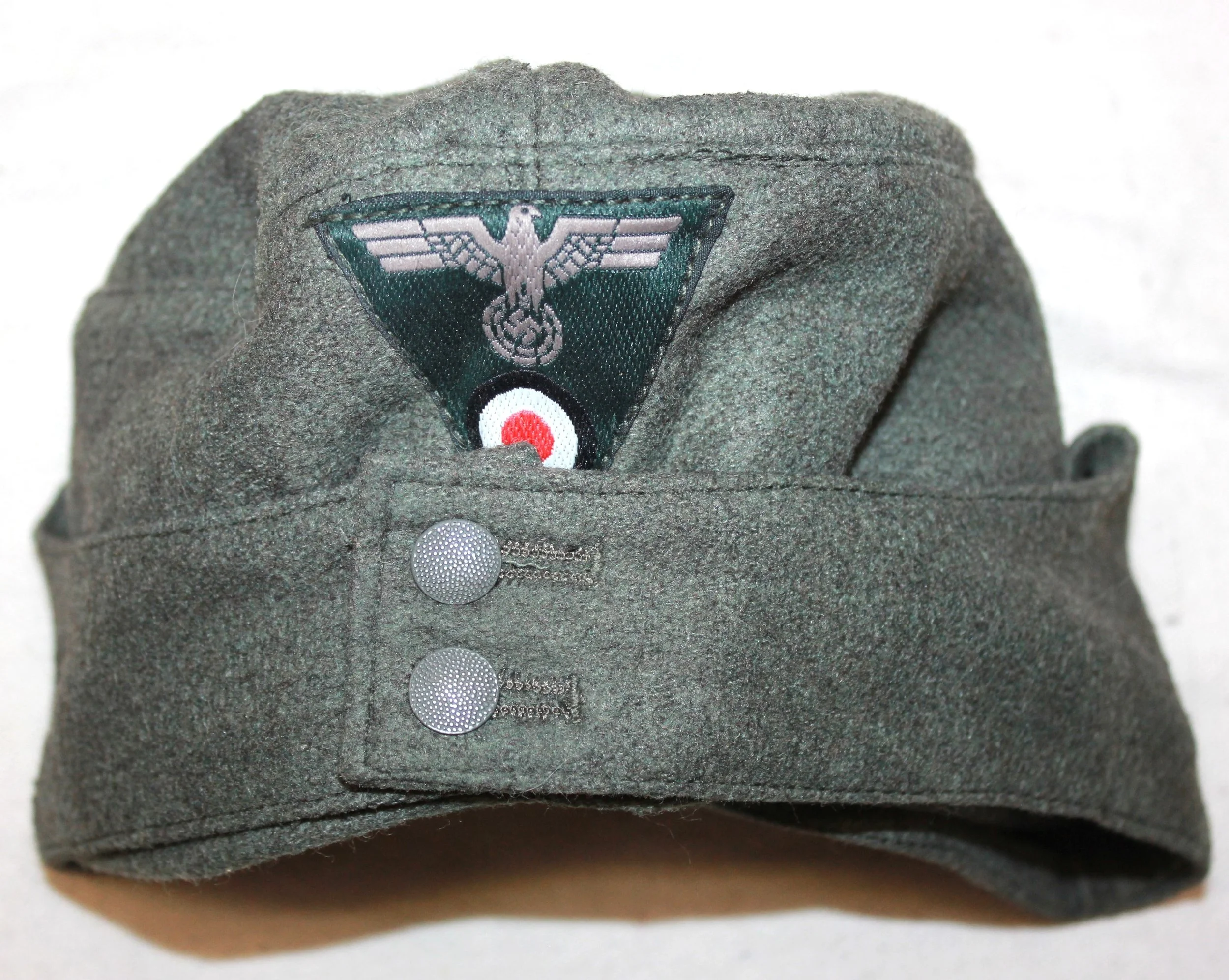
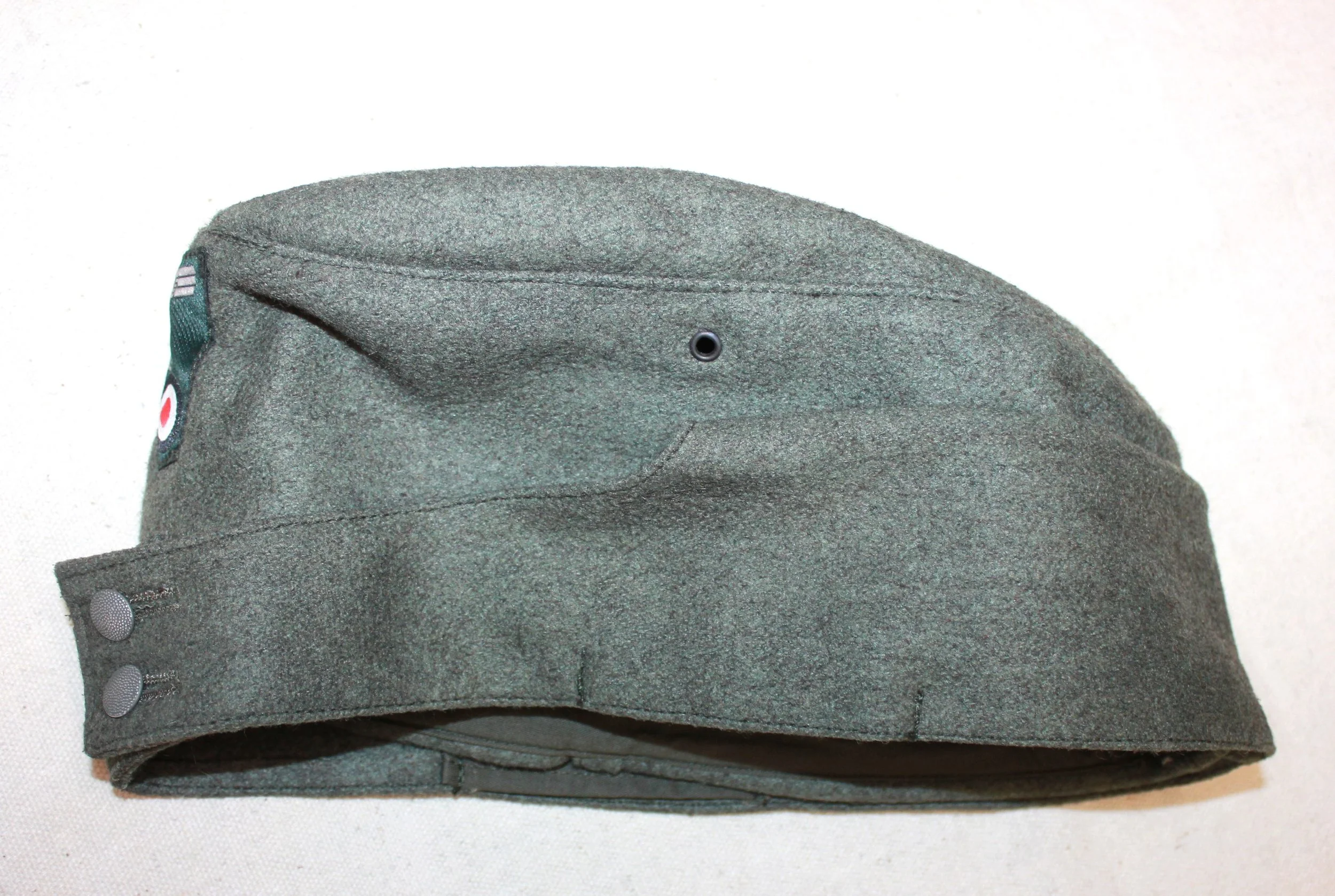






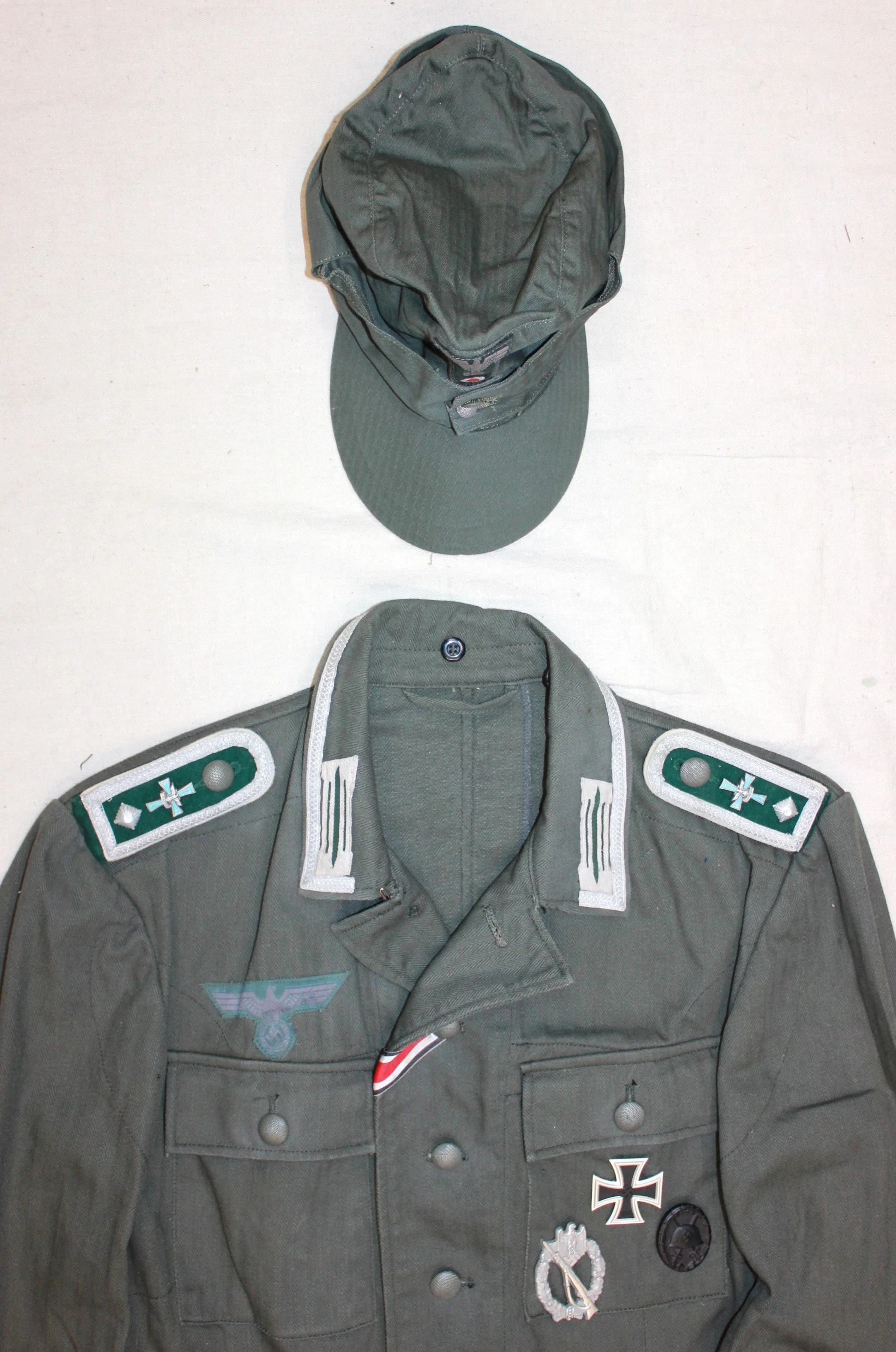




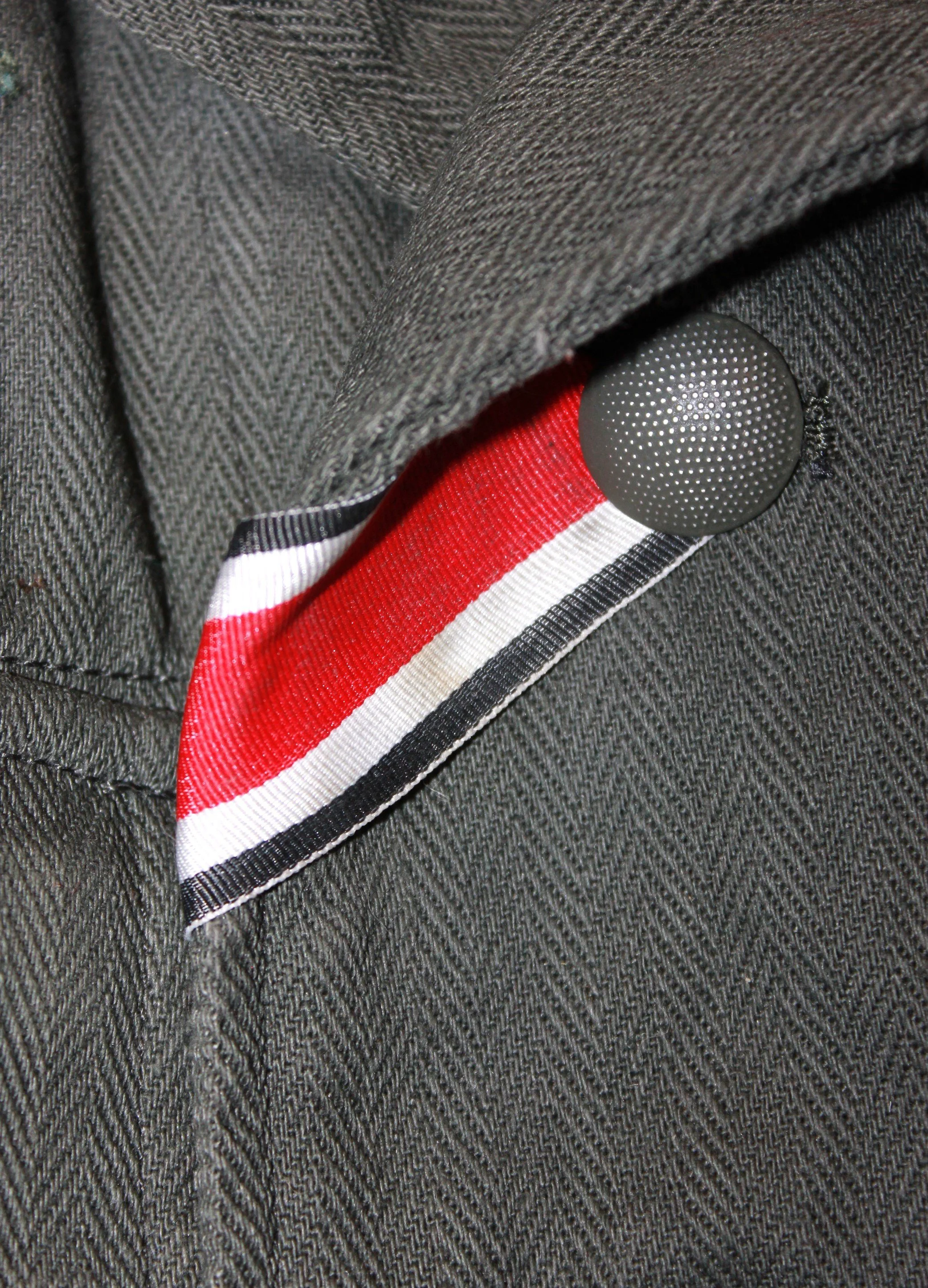
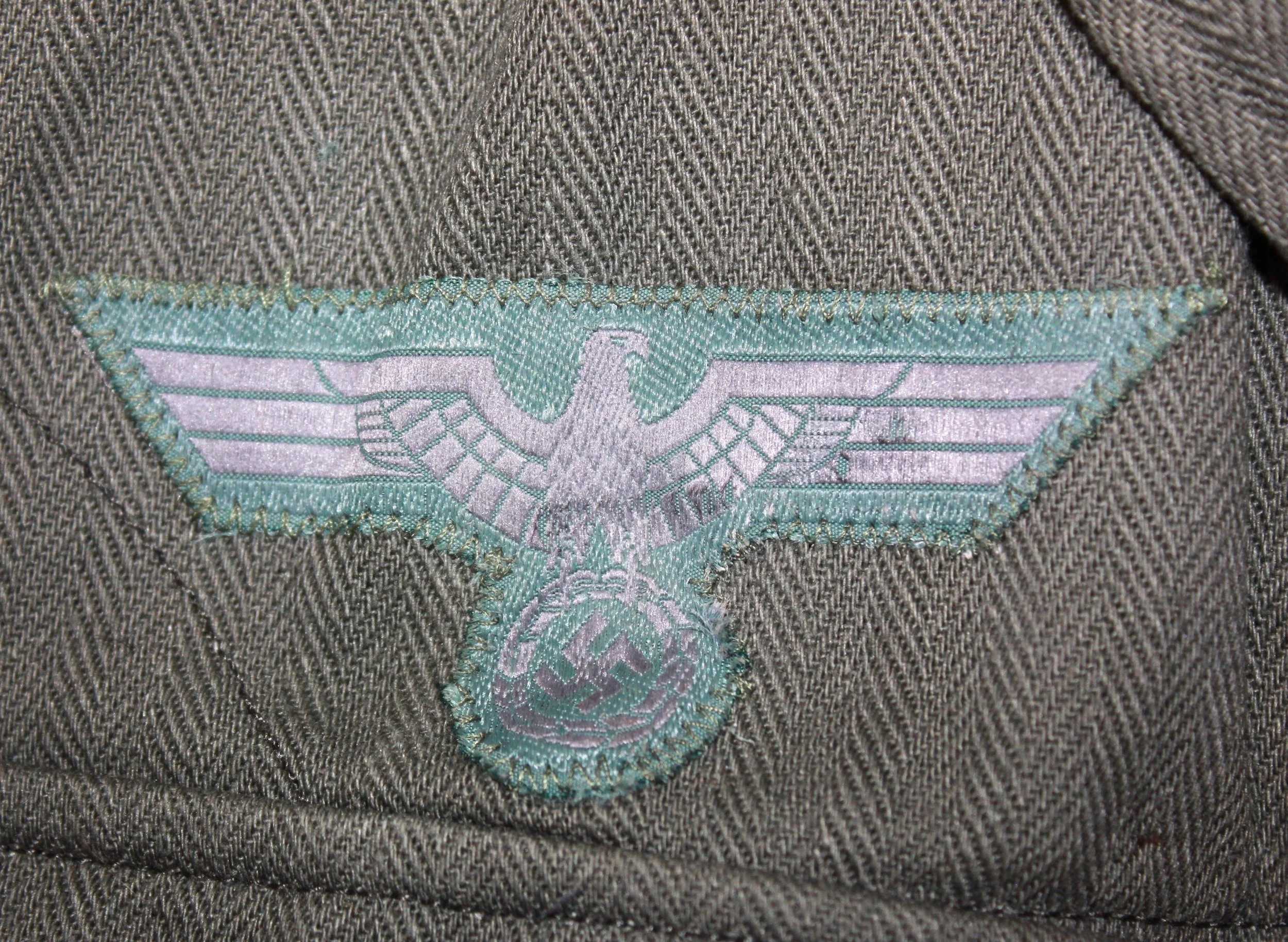
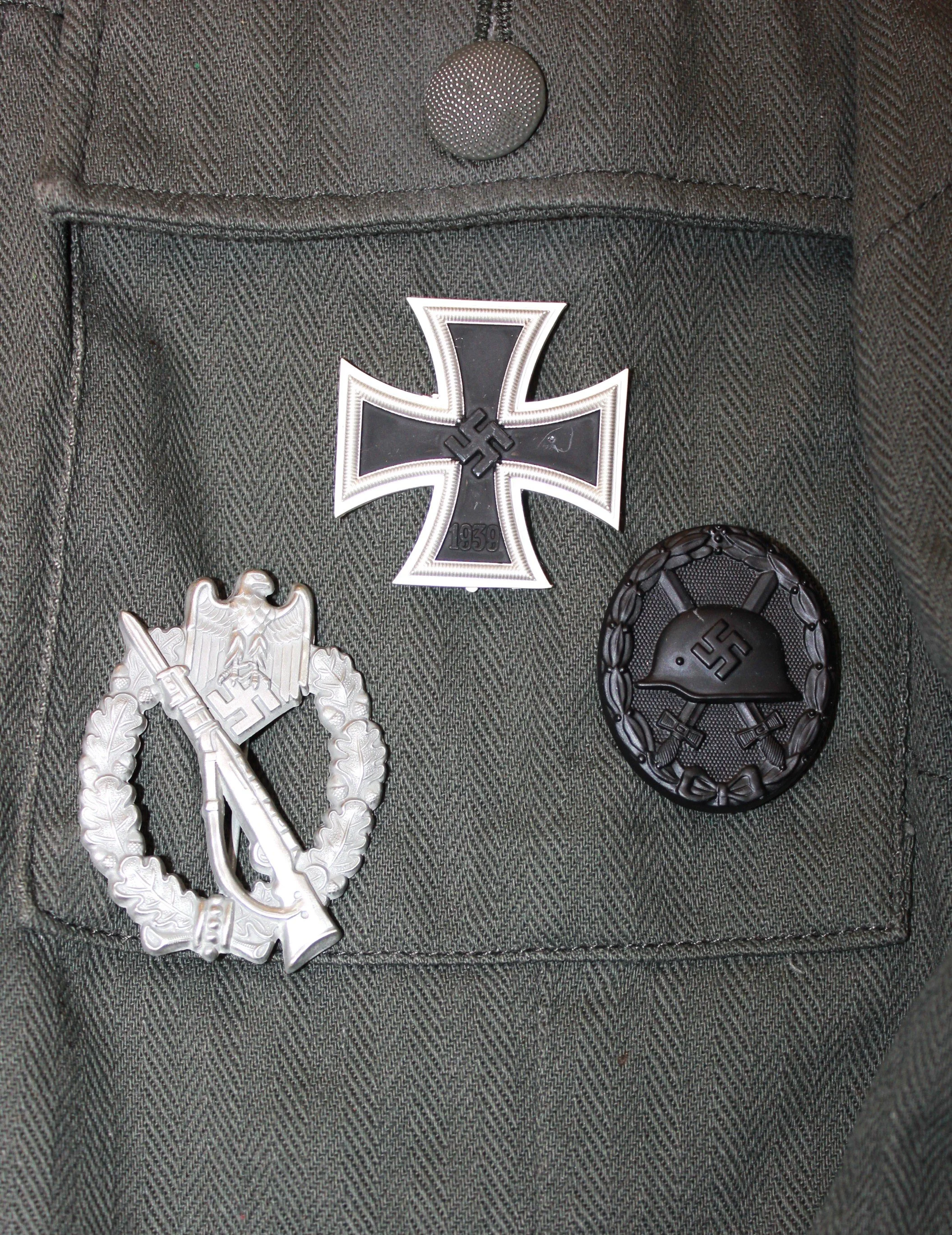




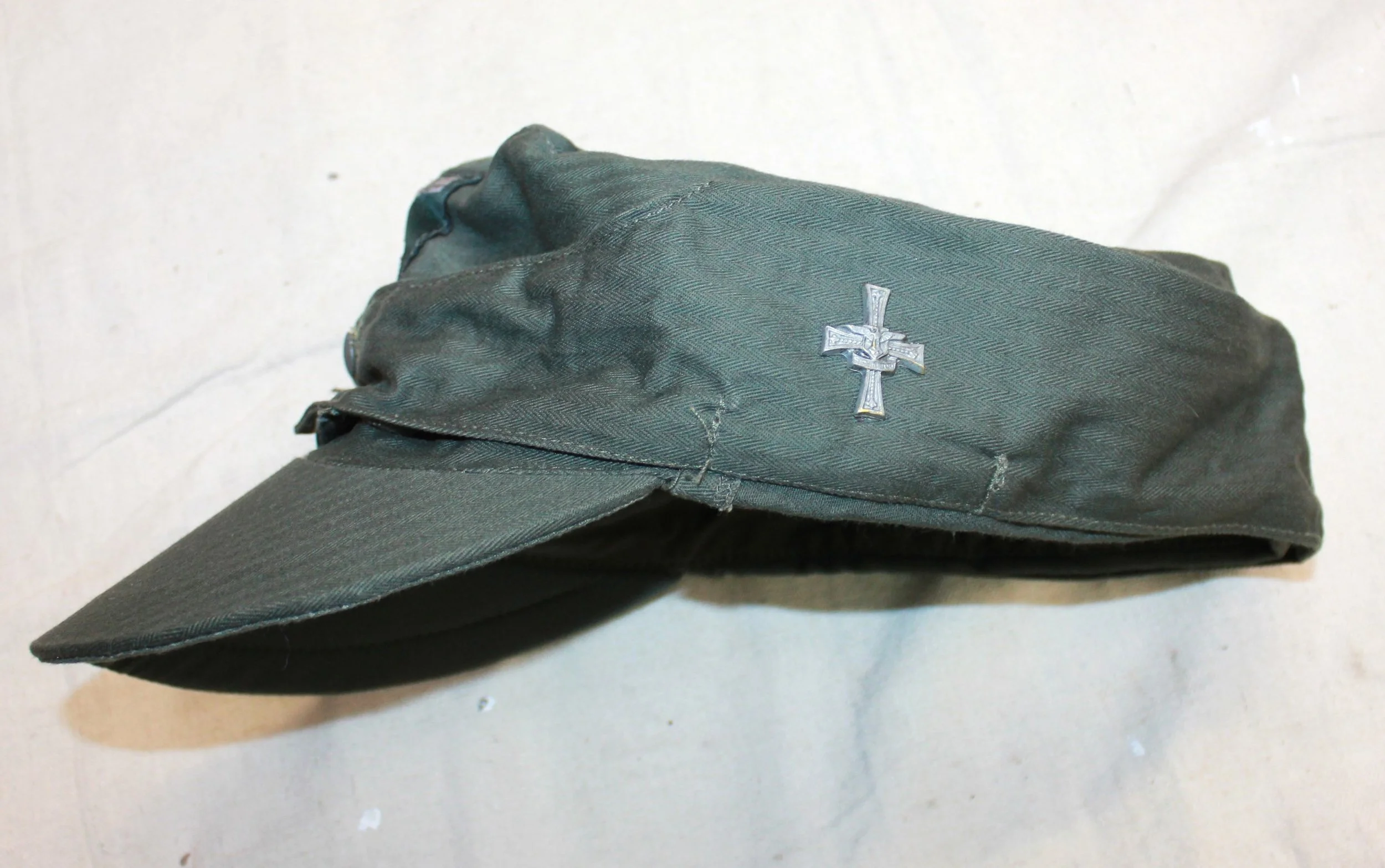







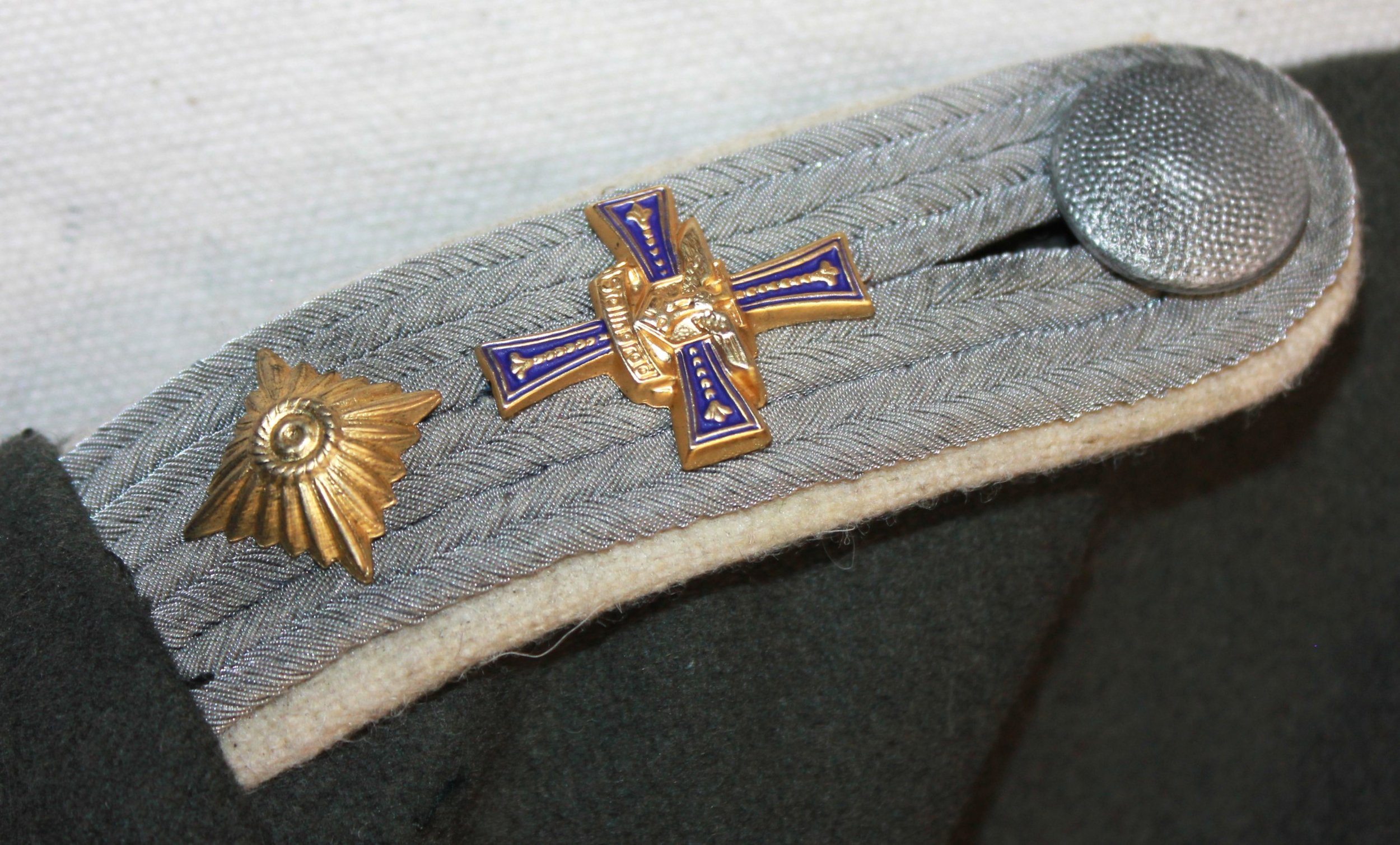











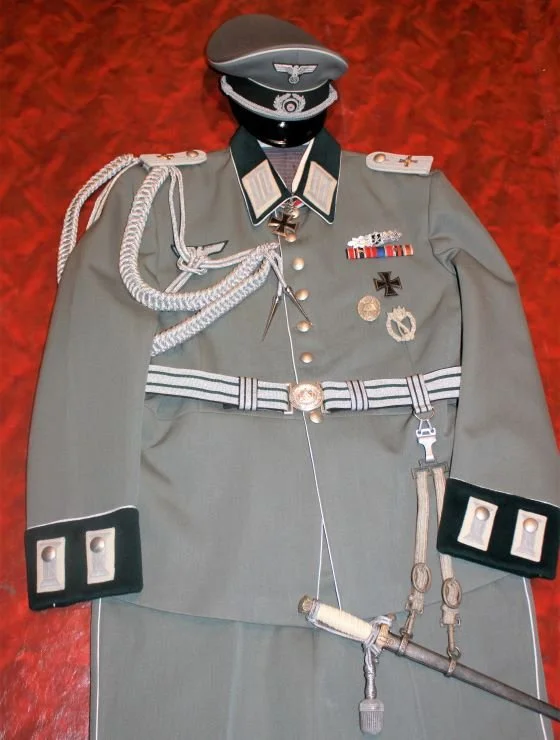


























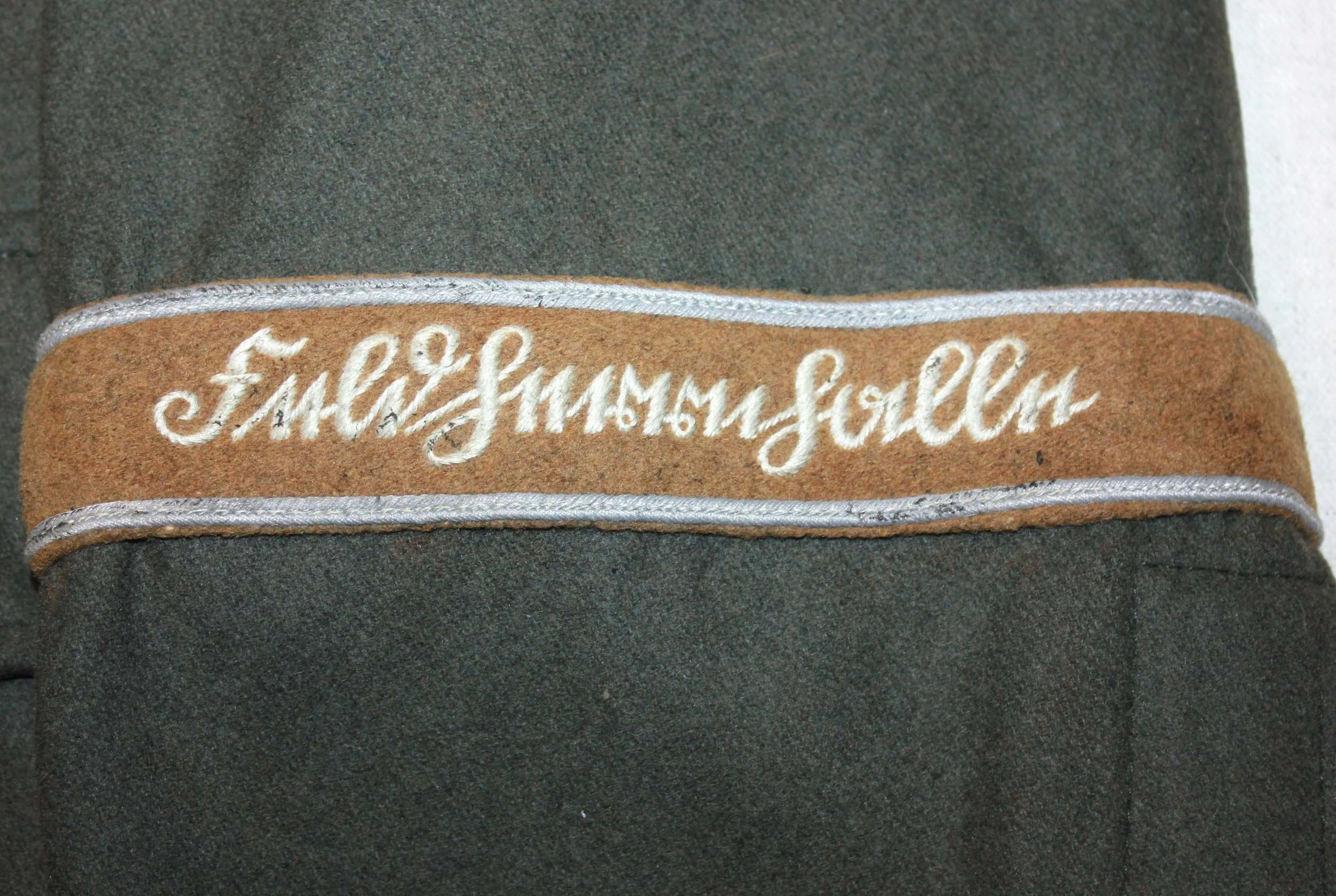

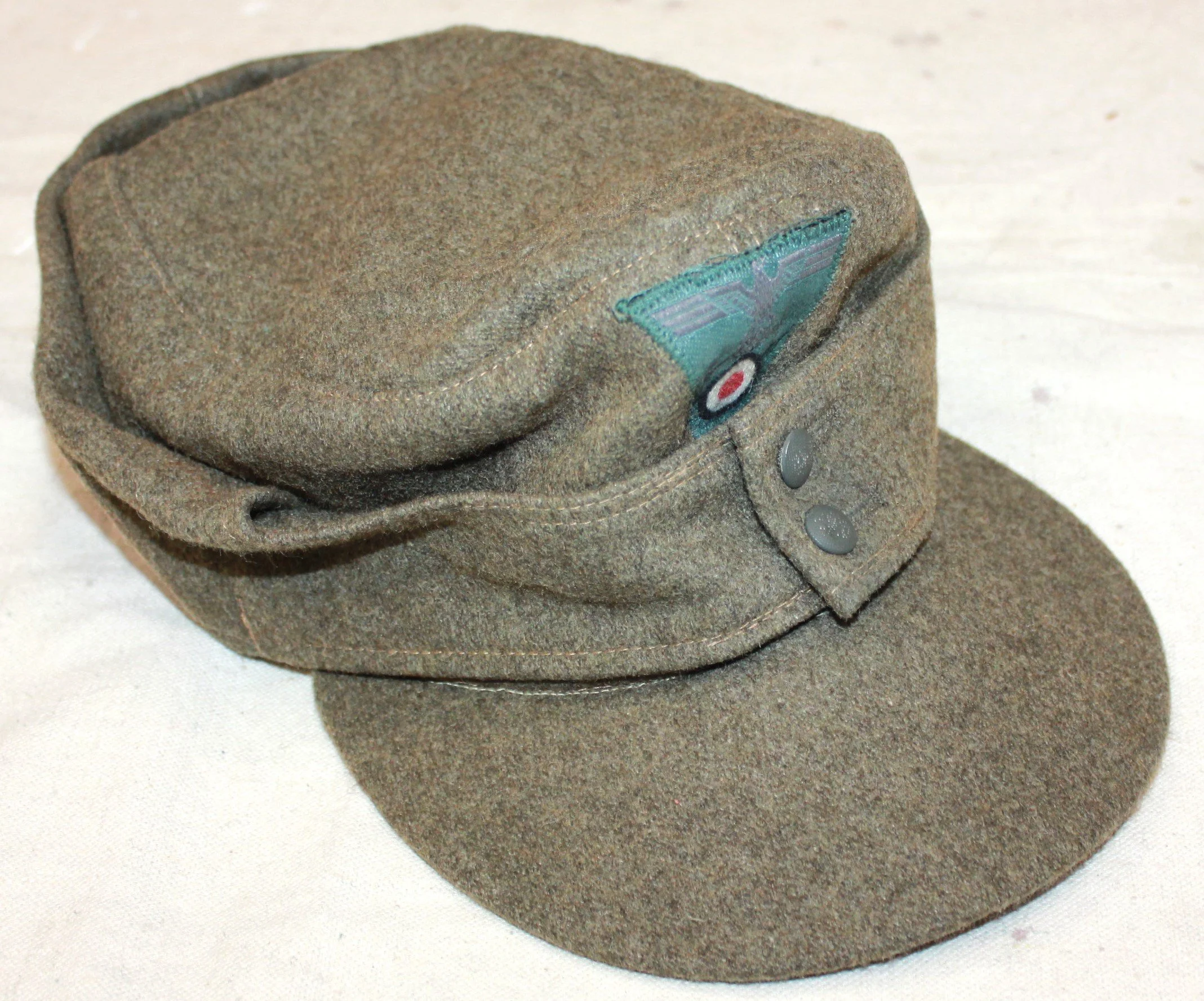



























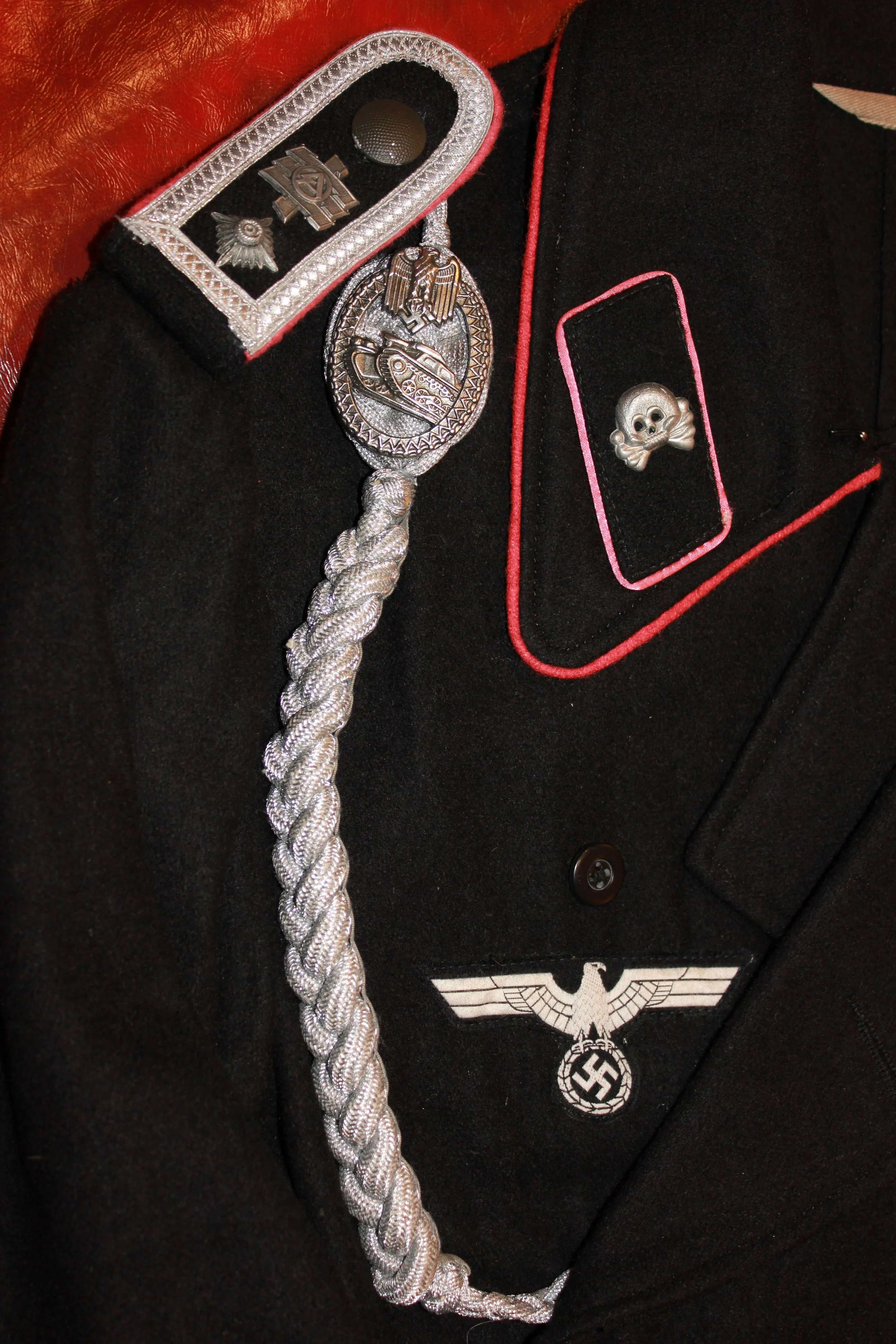

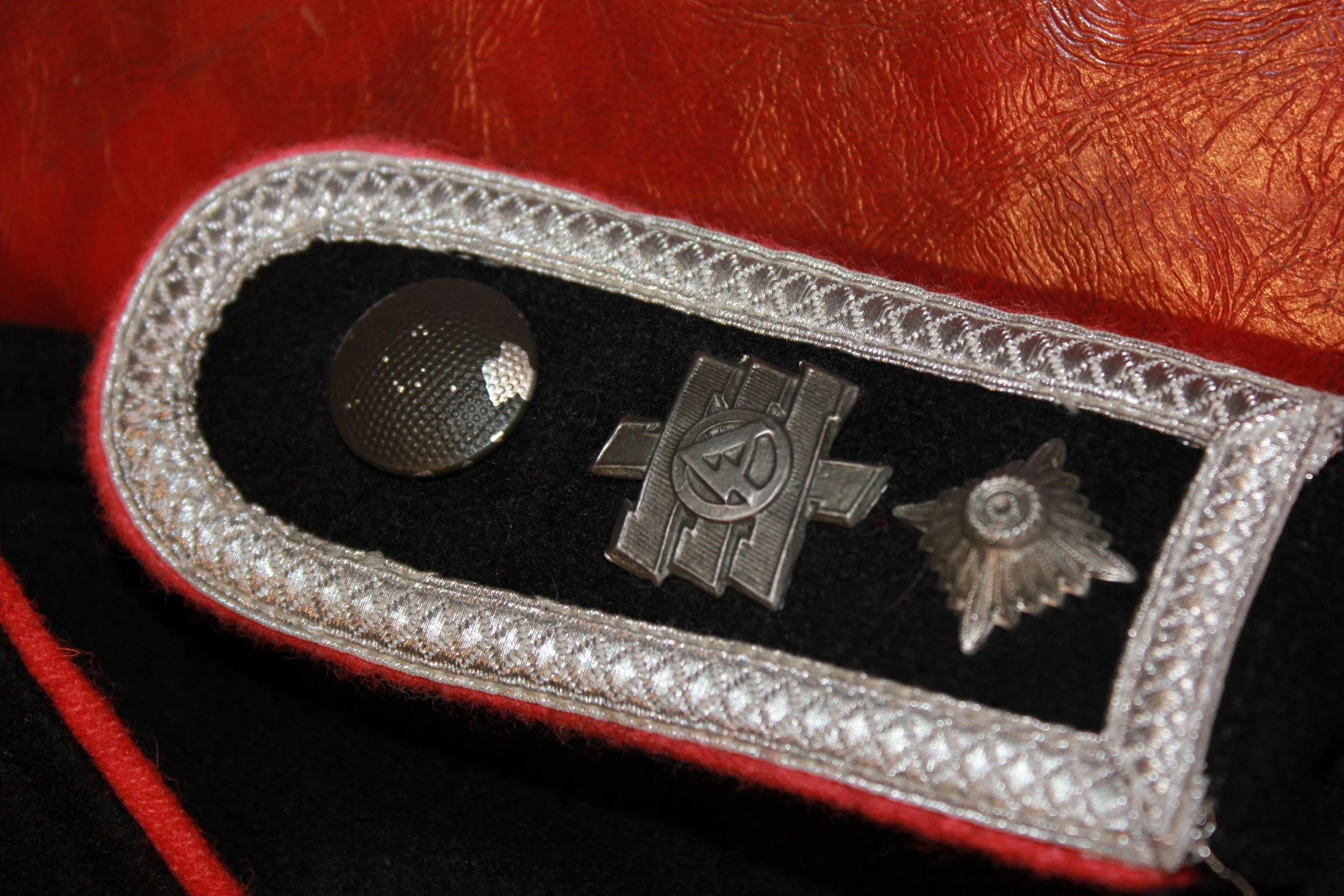
















![Feldherrnhalle-Helmet-Photo[1].jpg](https://images.squarespace-cdn.com/content/v1/61355b53c1baef12641a2de9/1678086415261-CO5VN4F2TNUZZ5S5DVA6/Feldherrnhalle-Helmet-Photo%5B1%5D.jpg)





